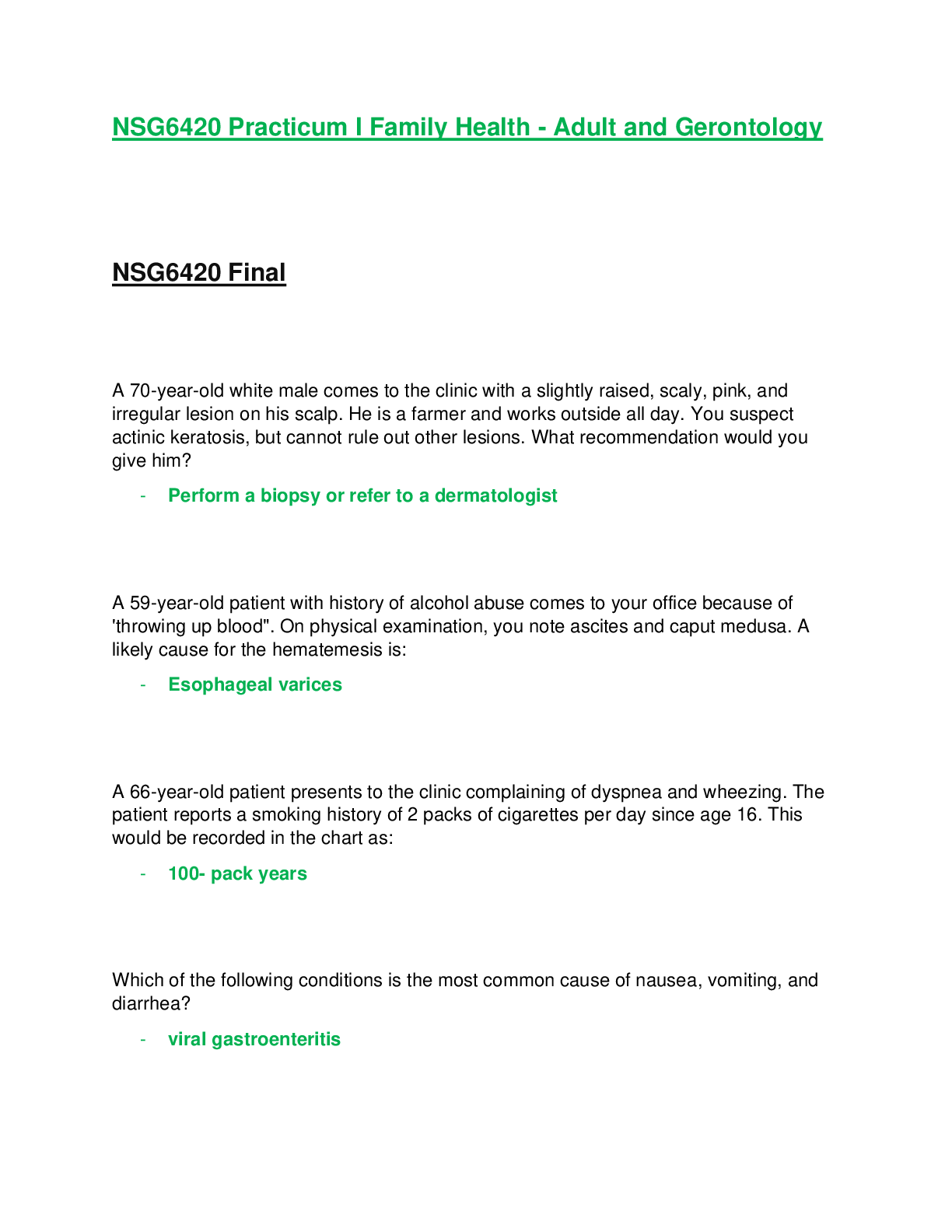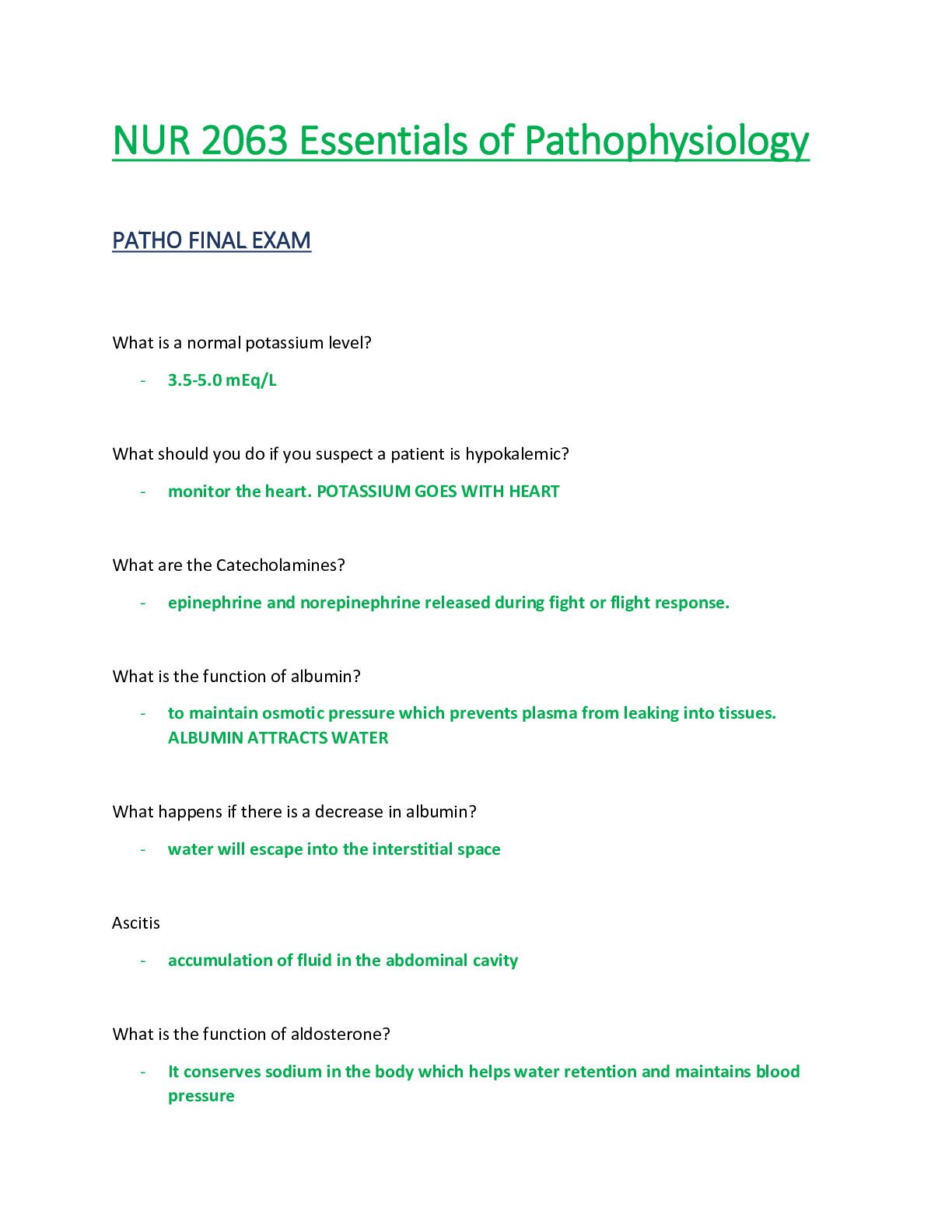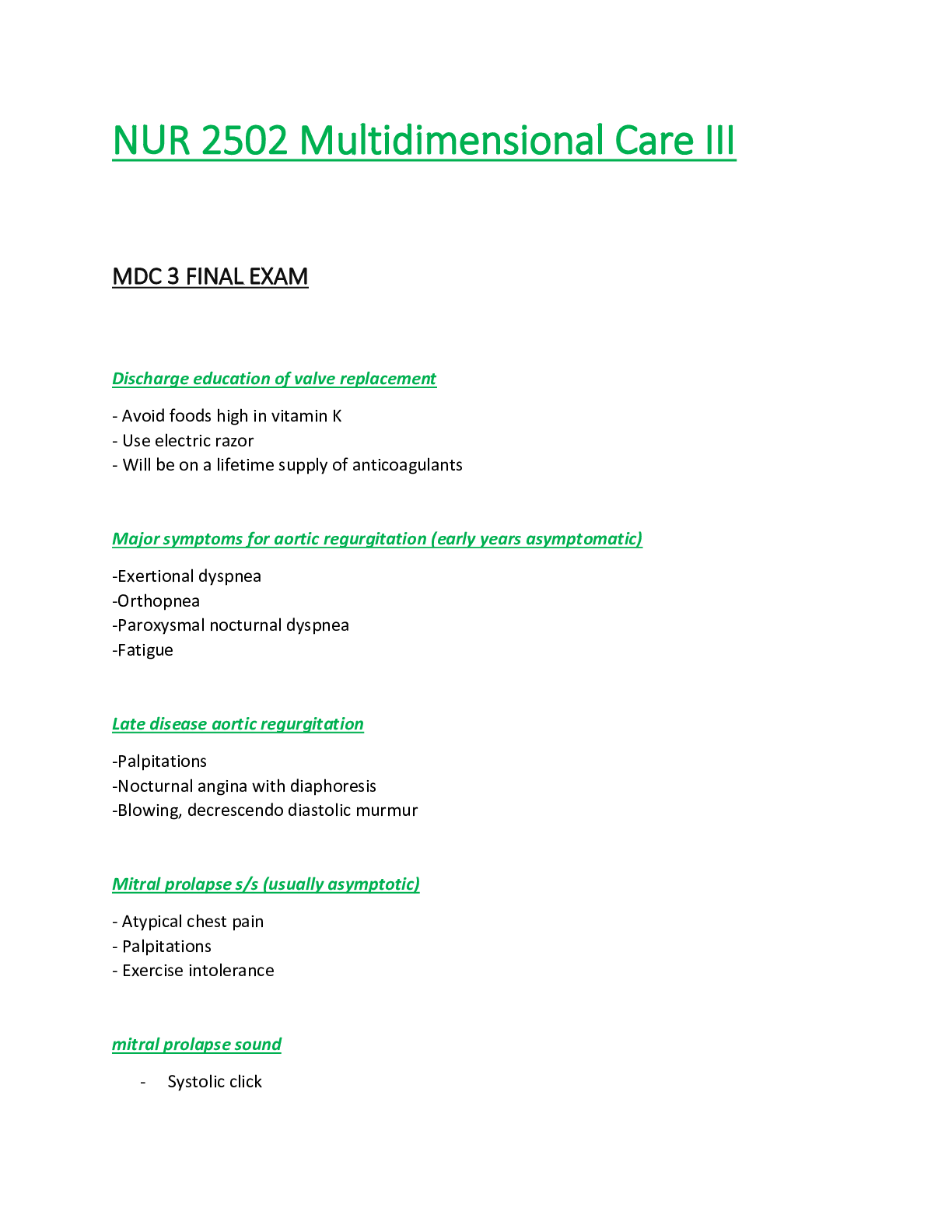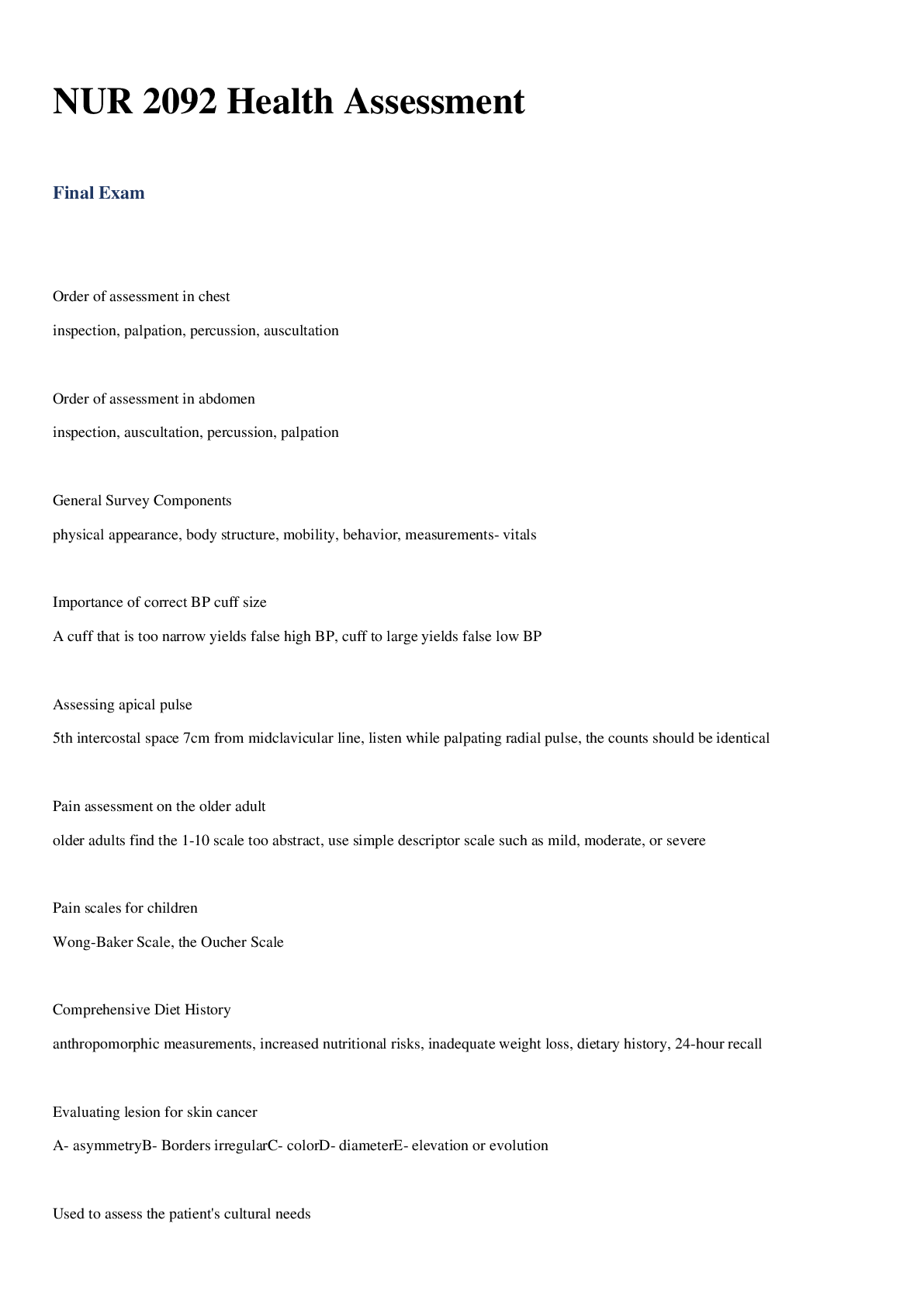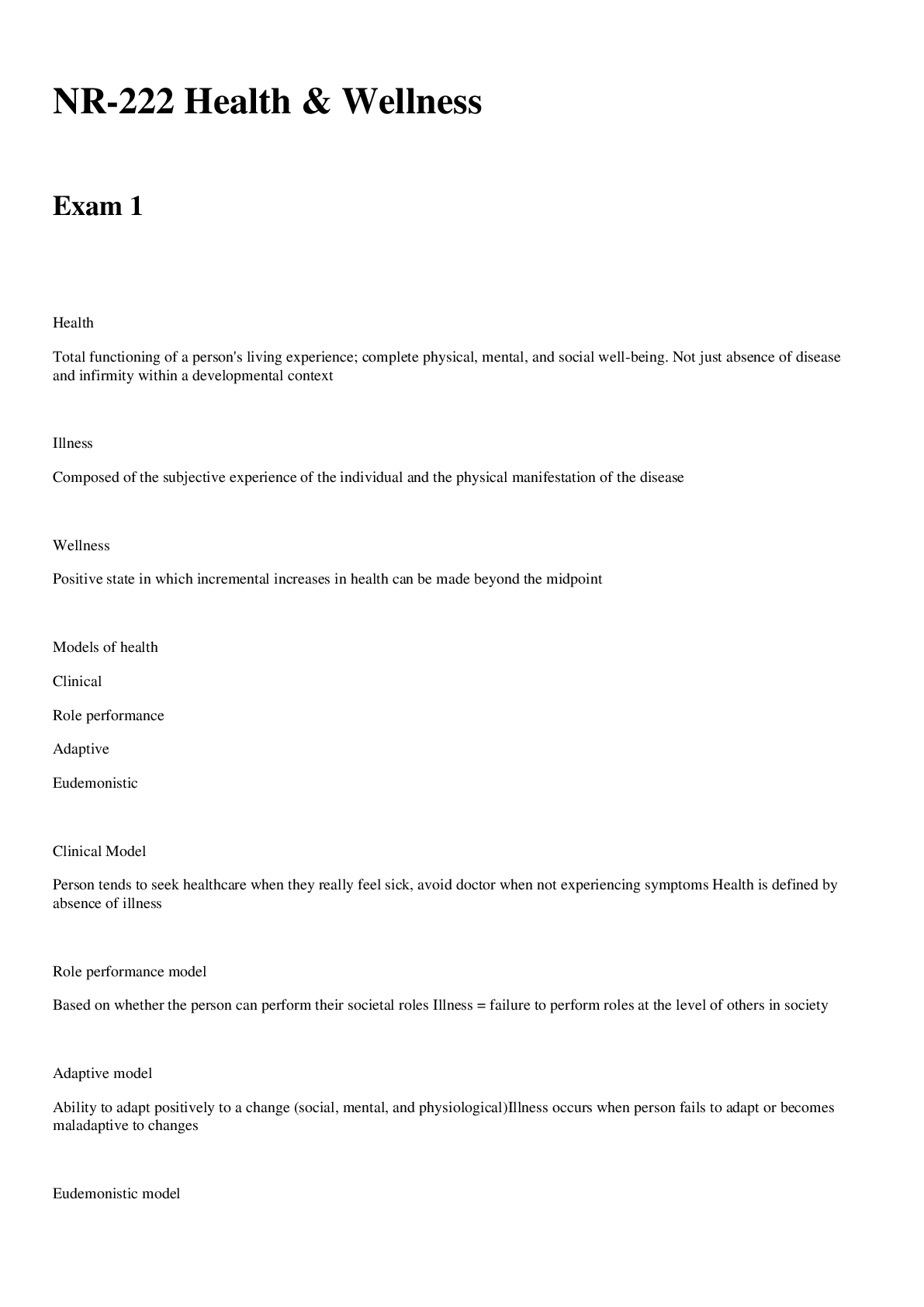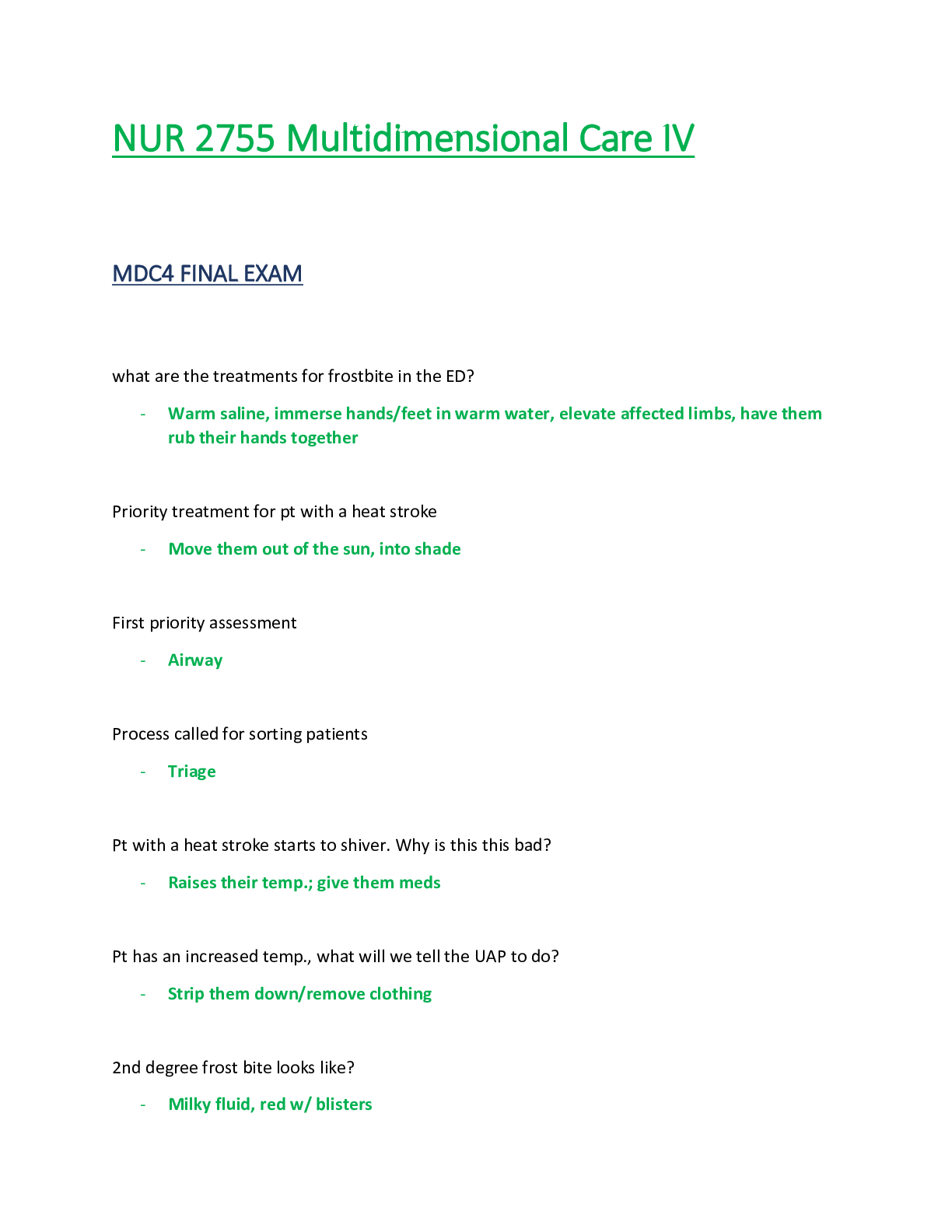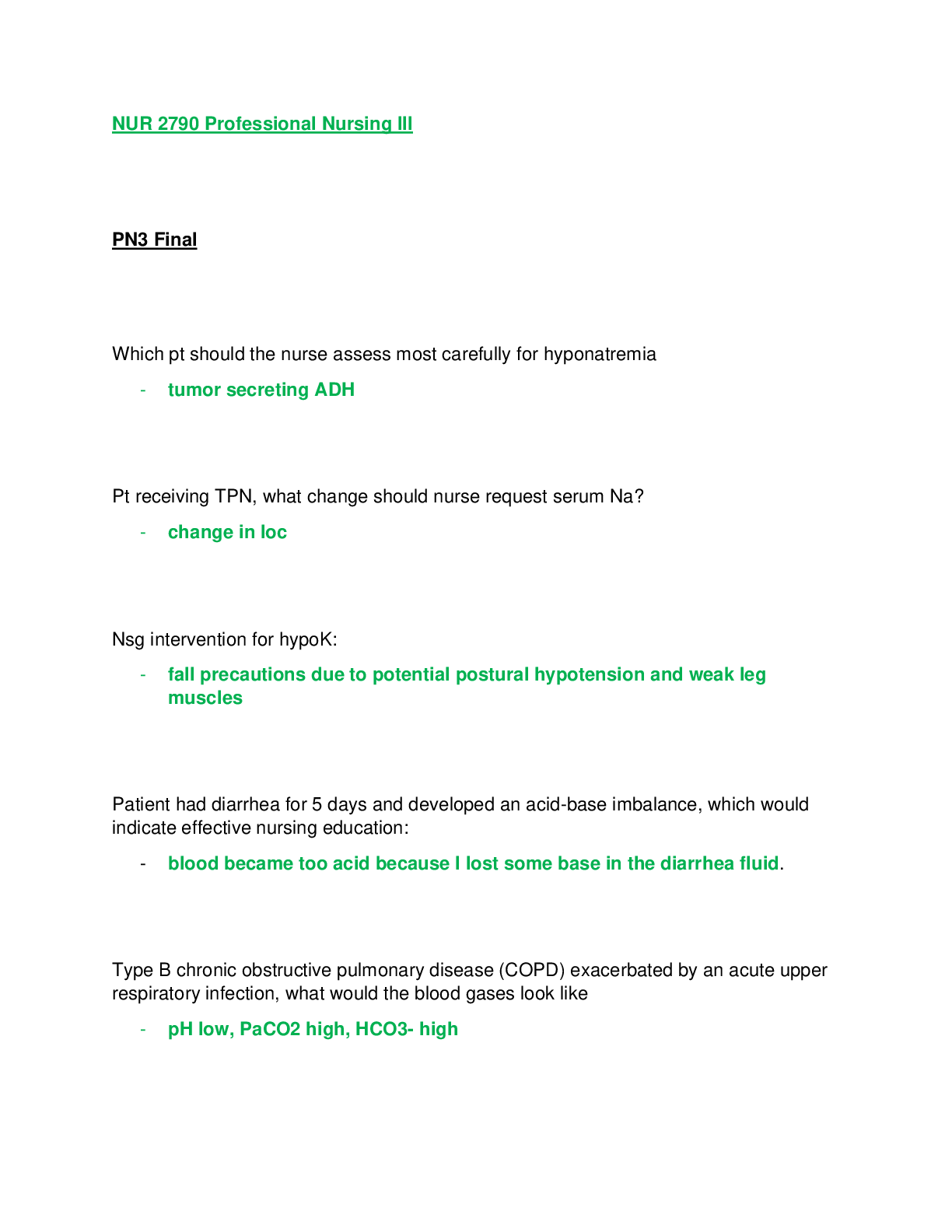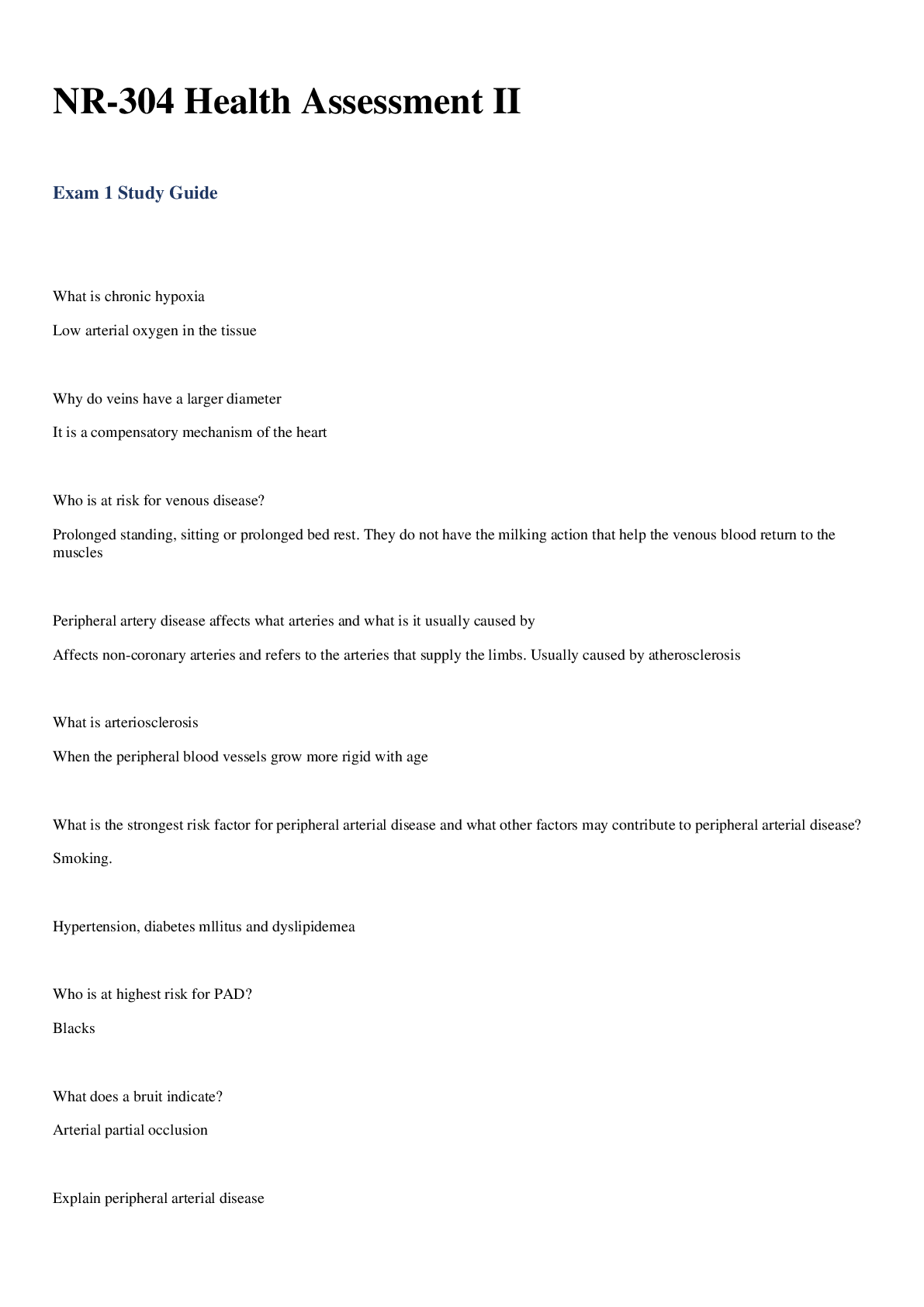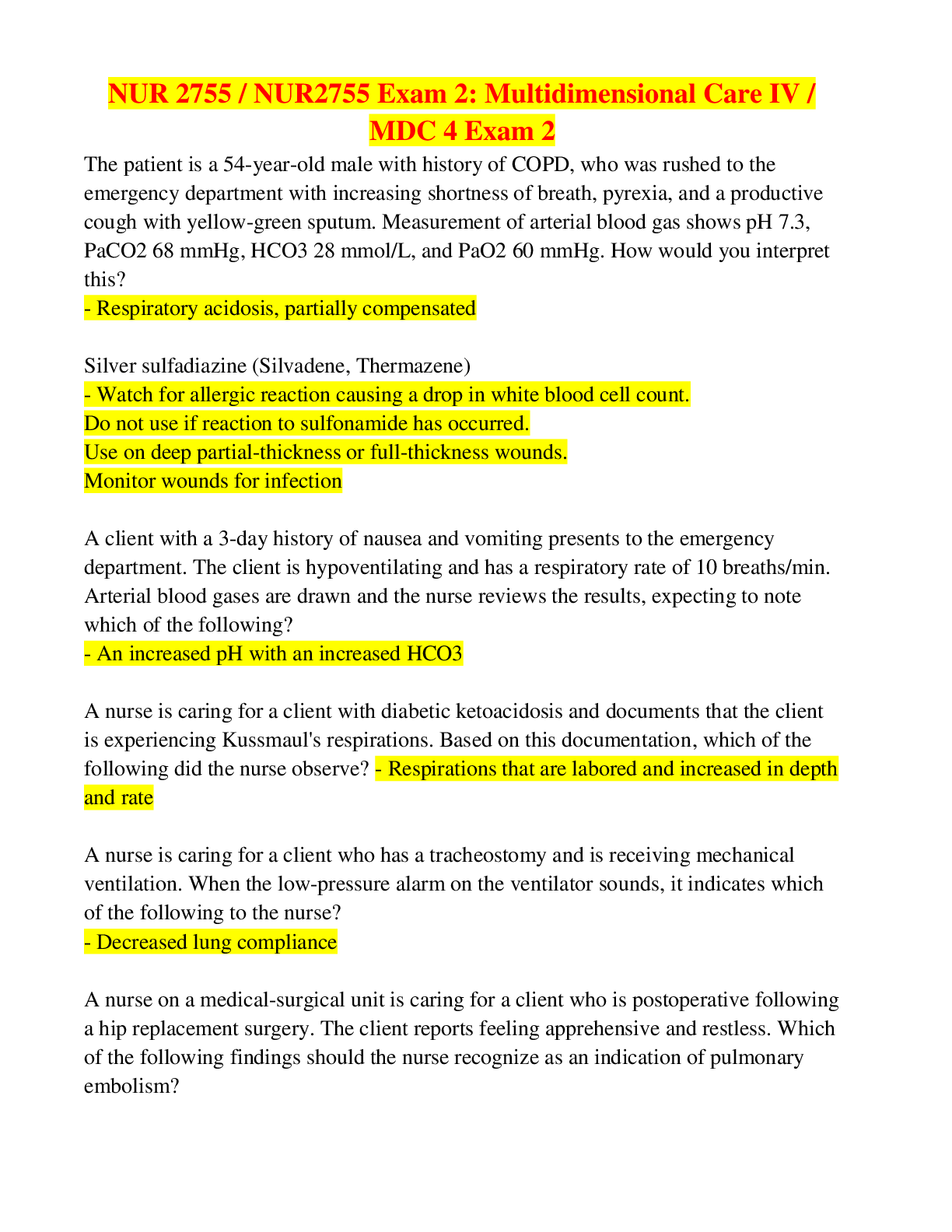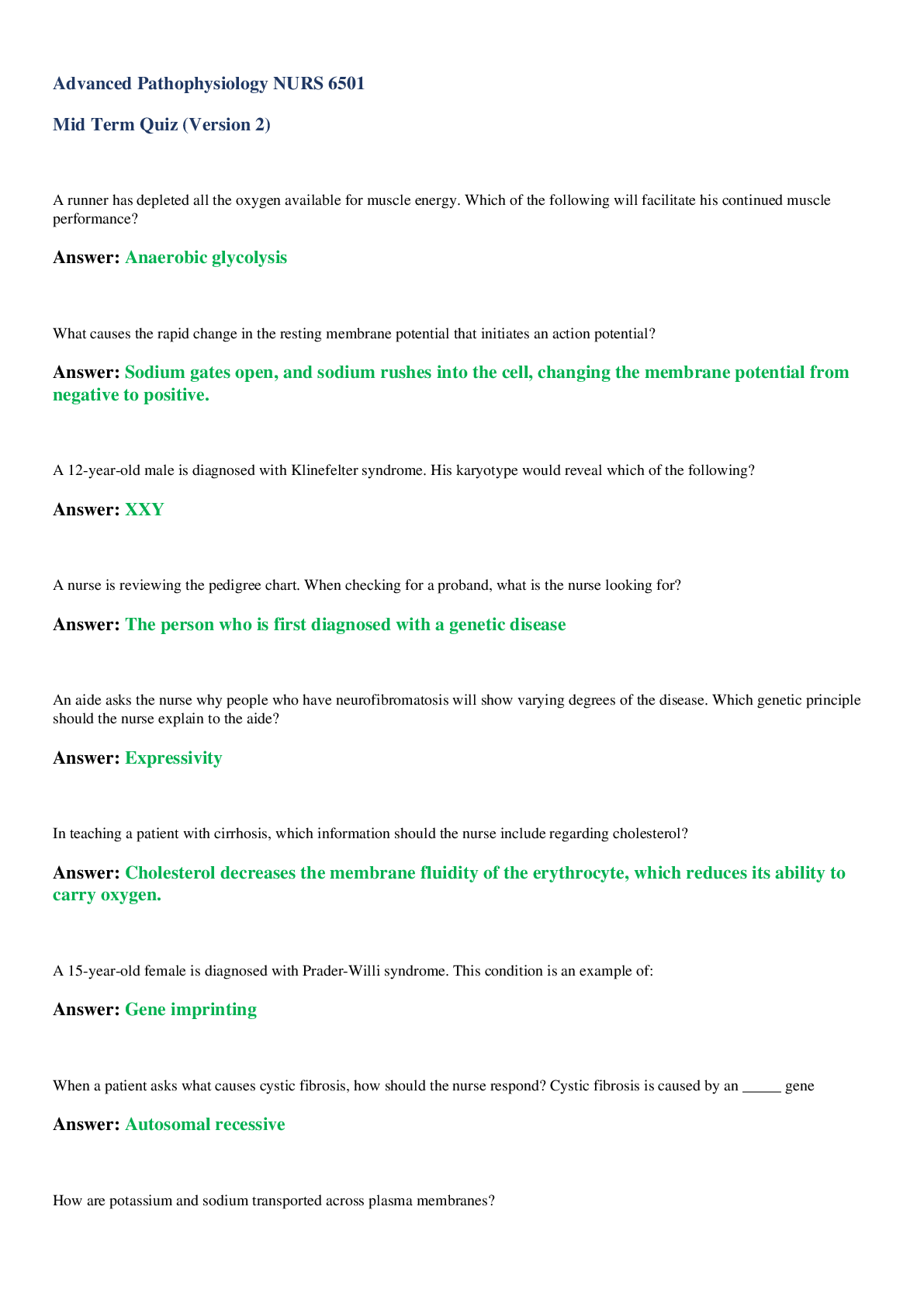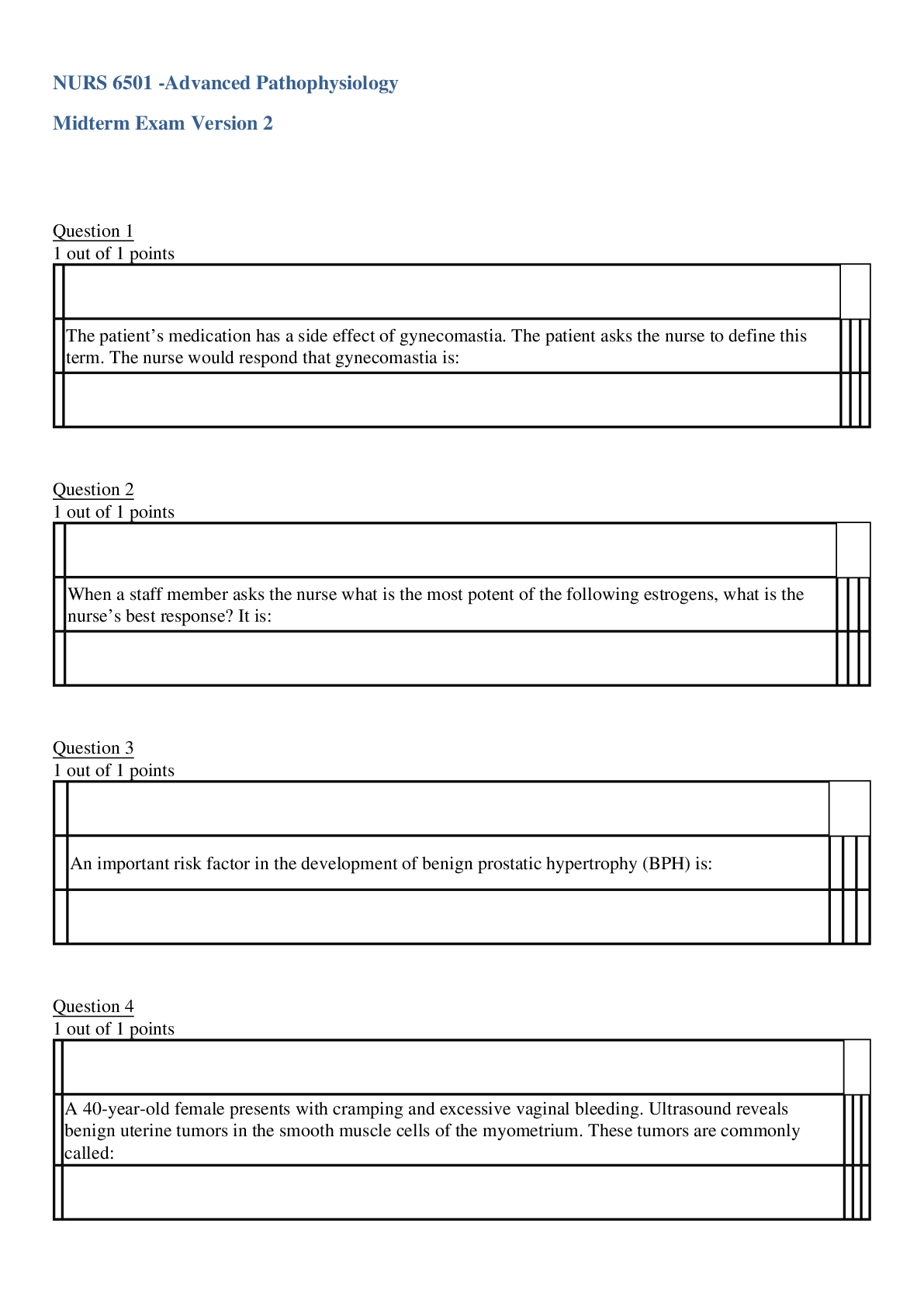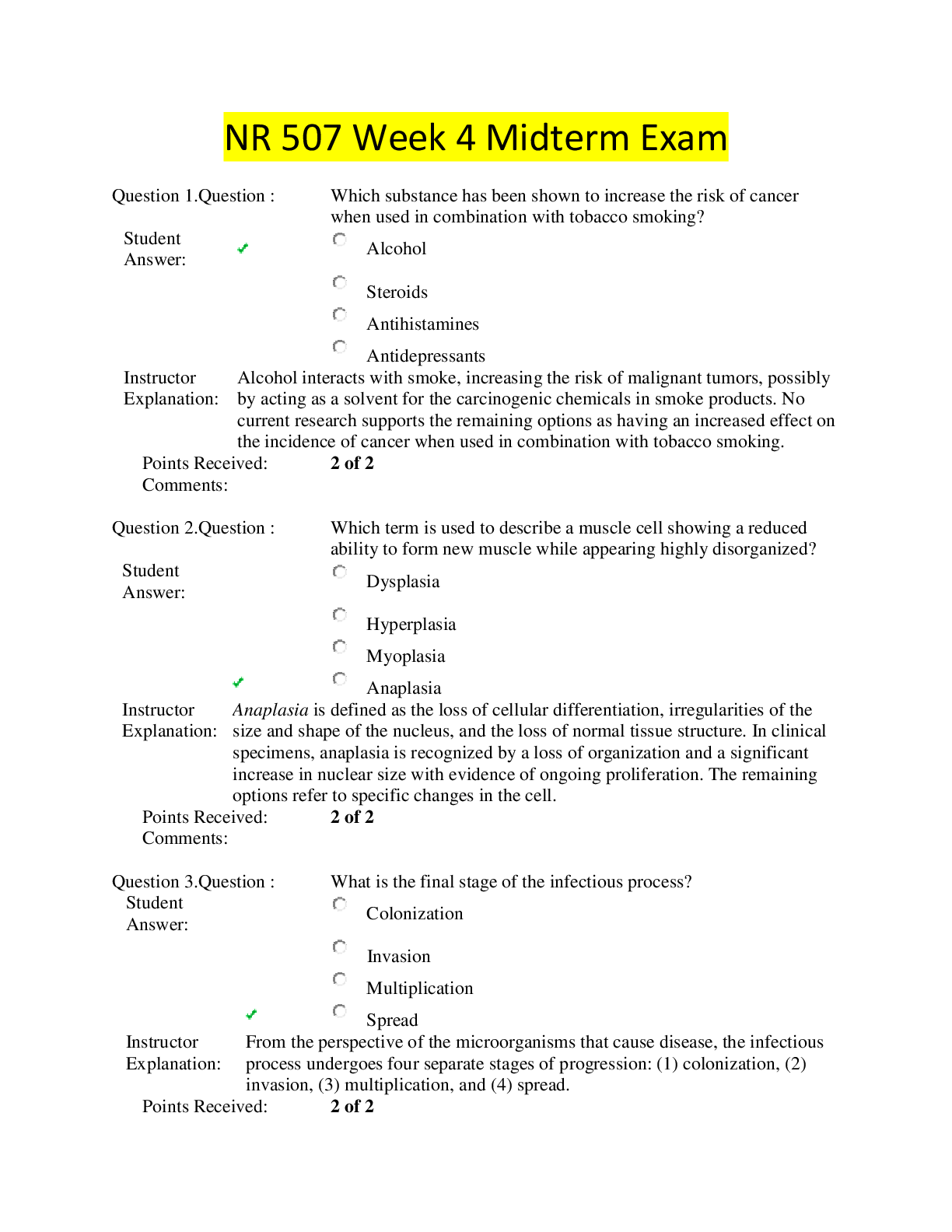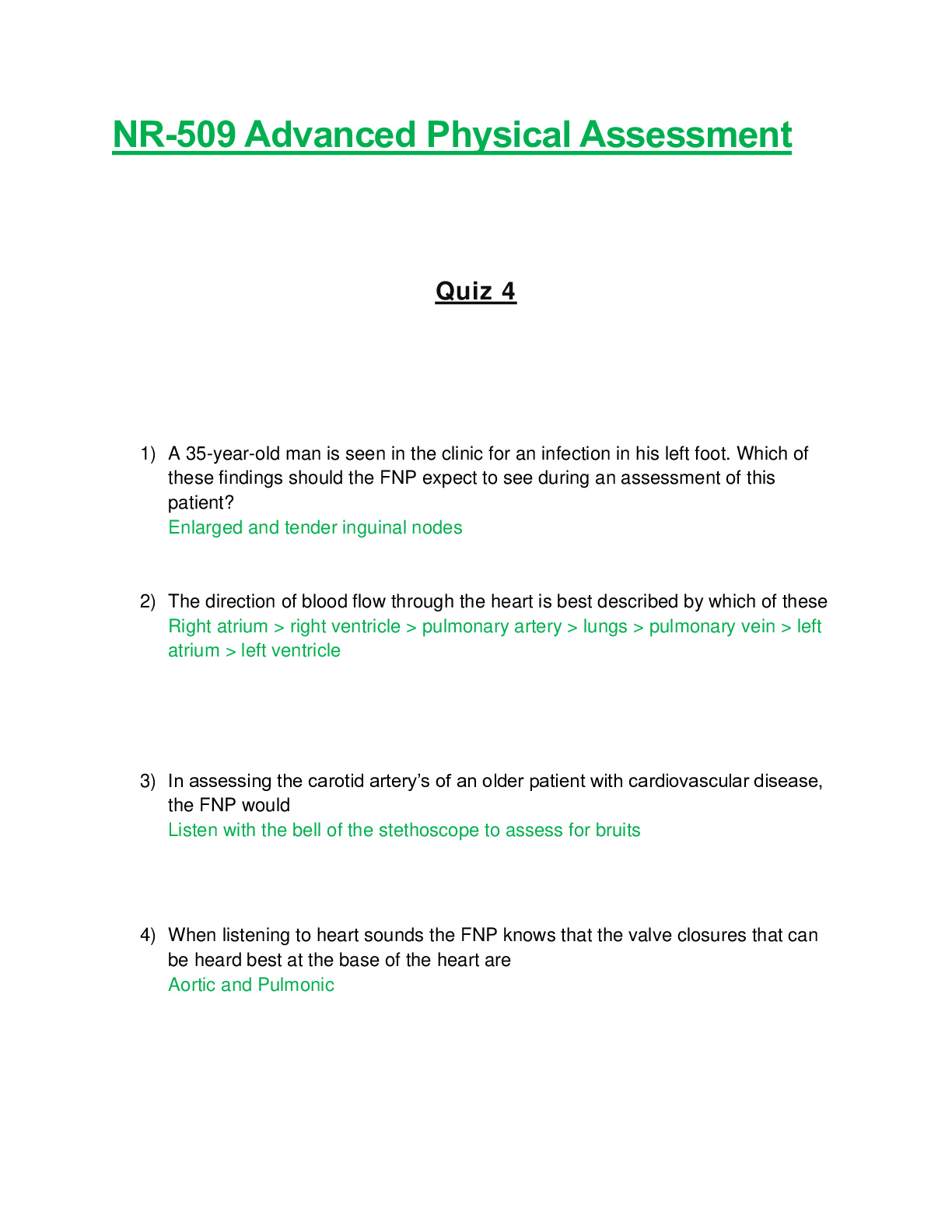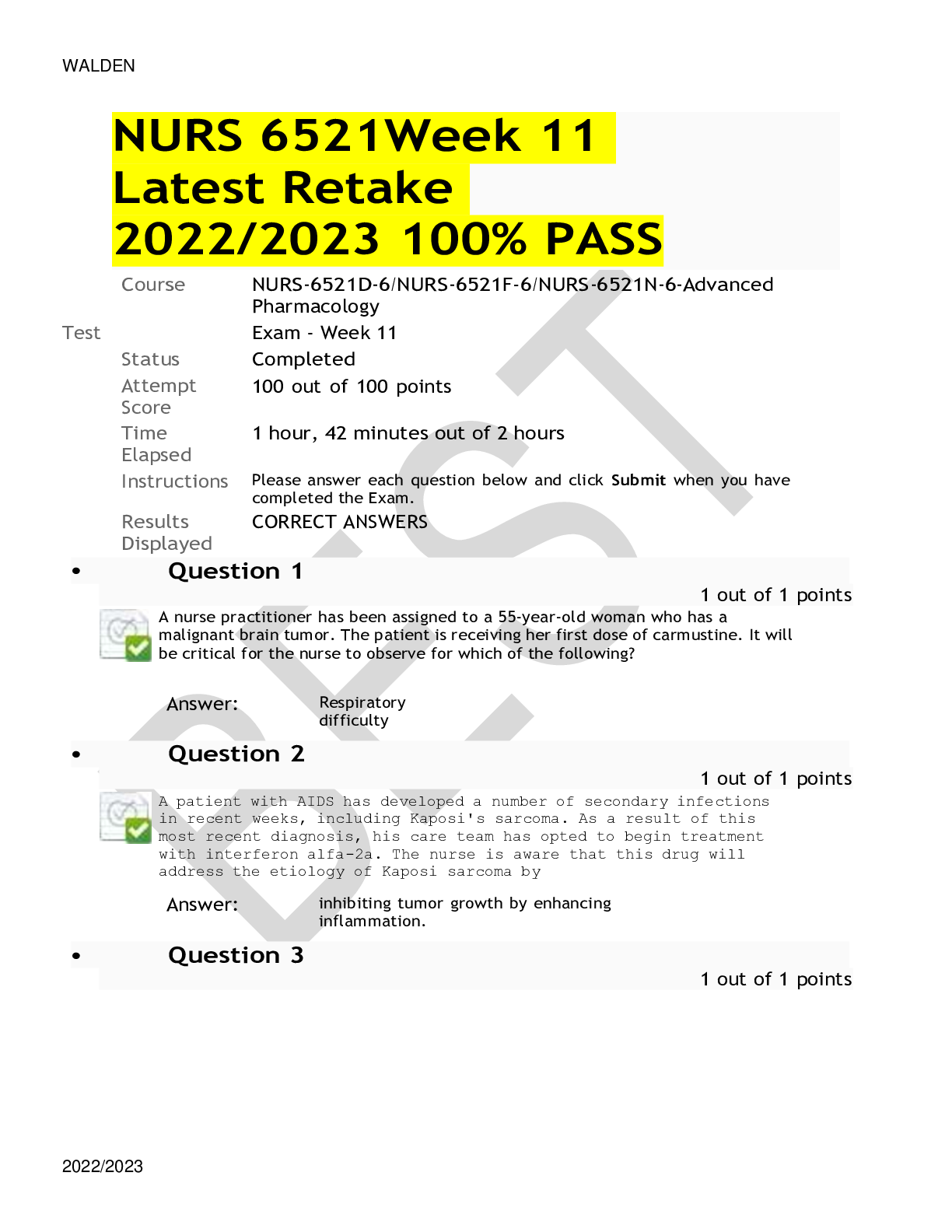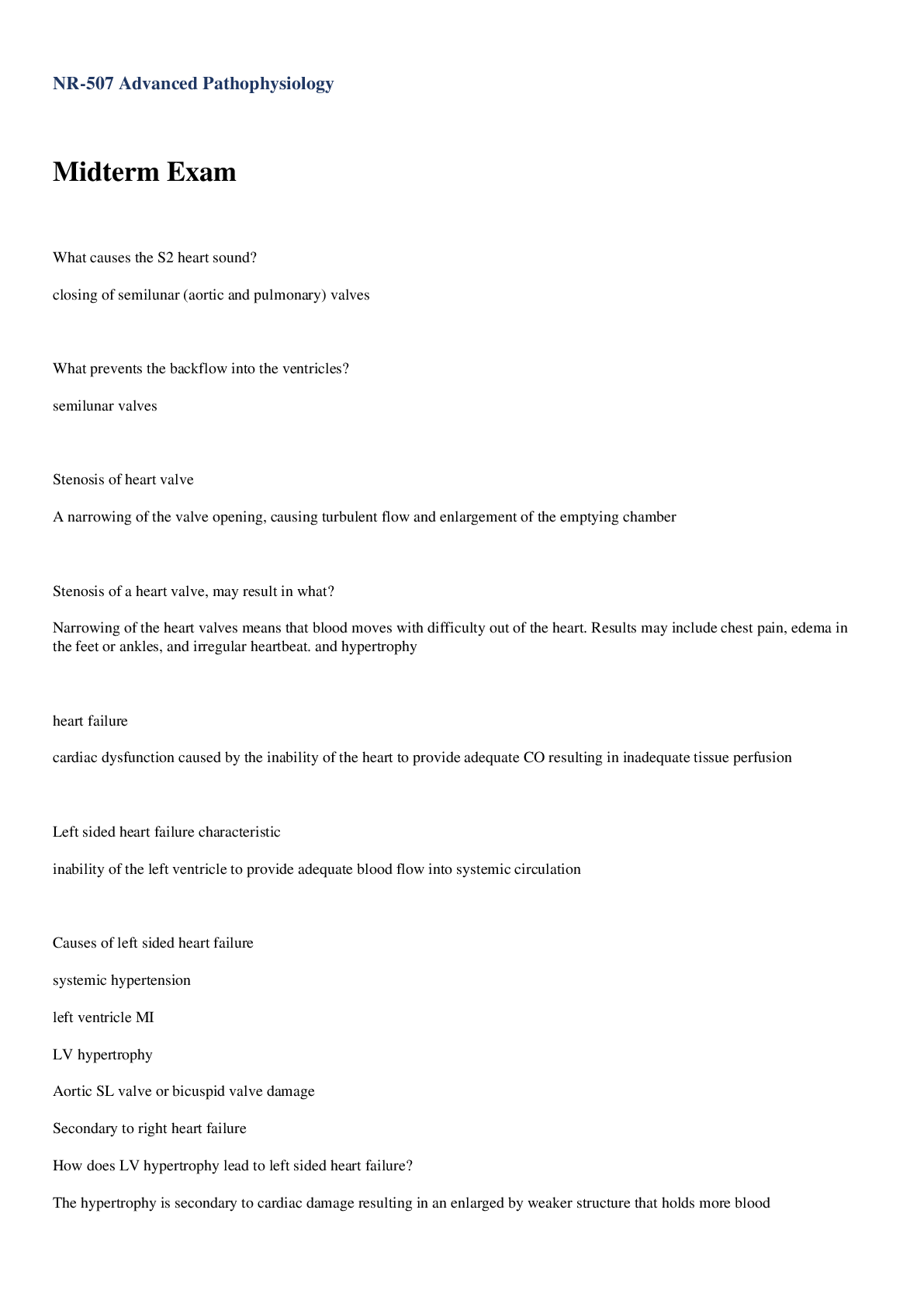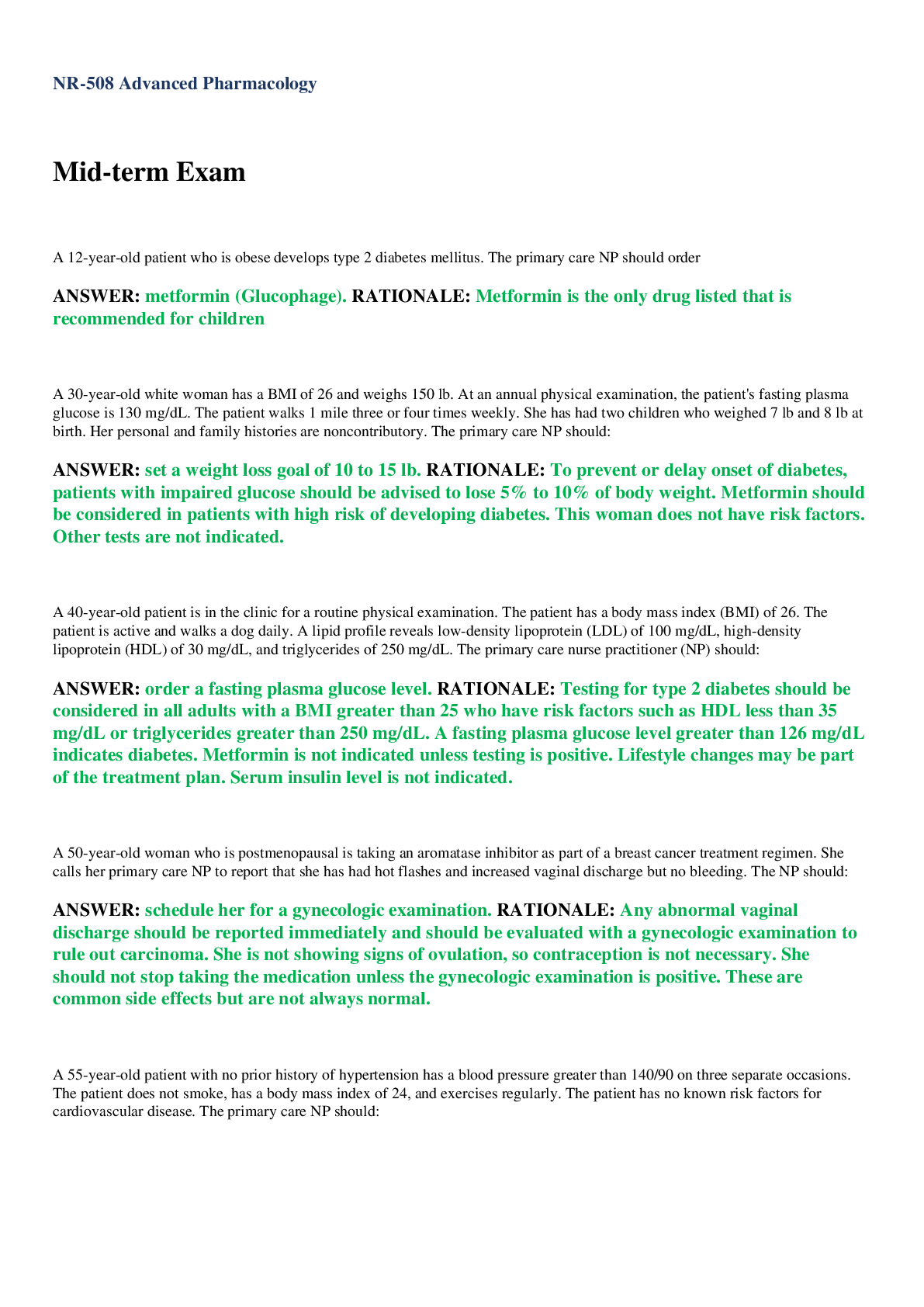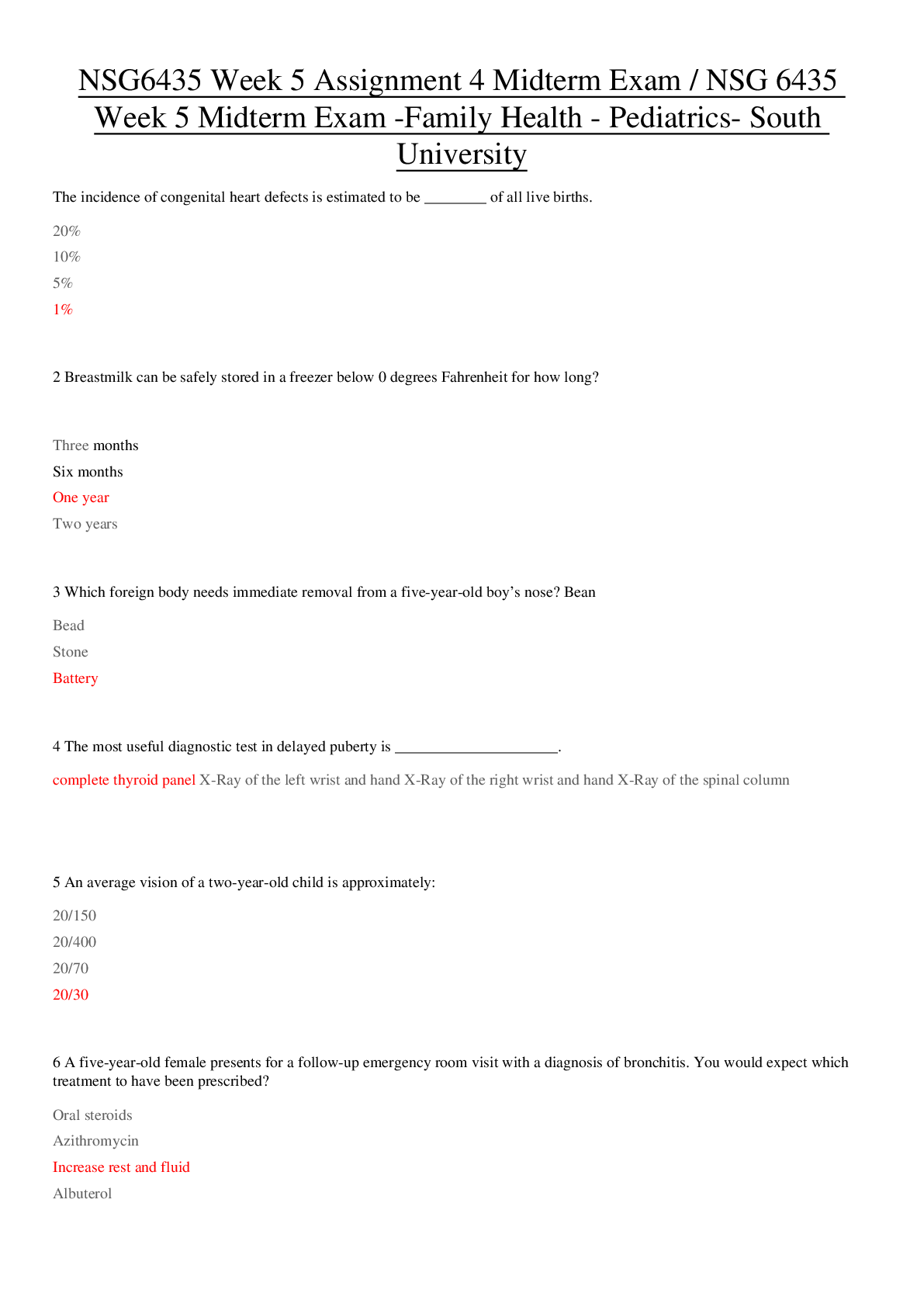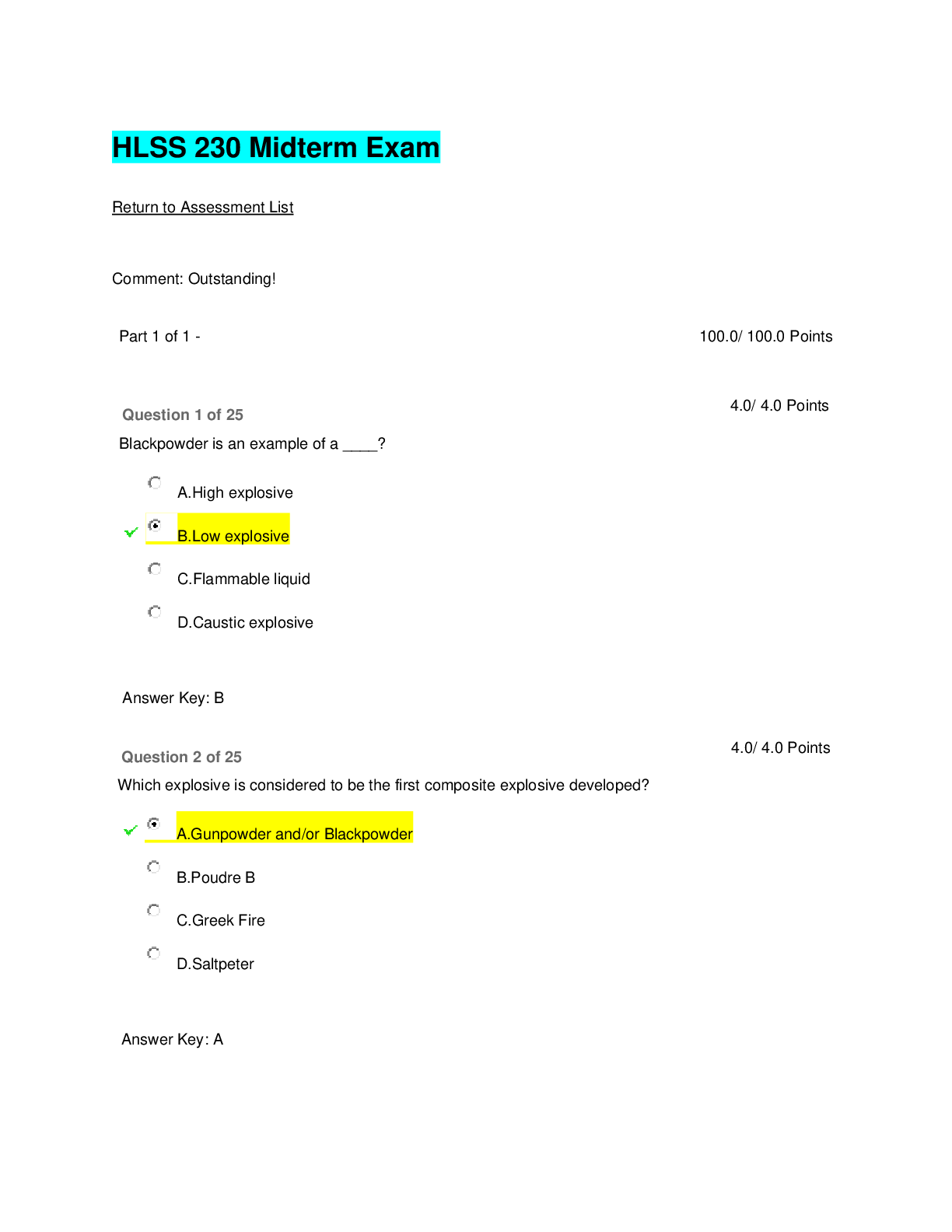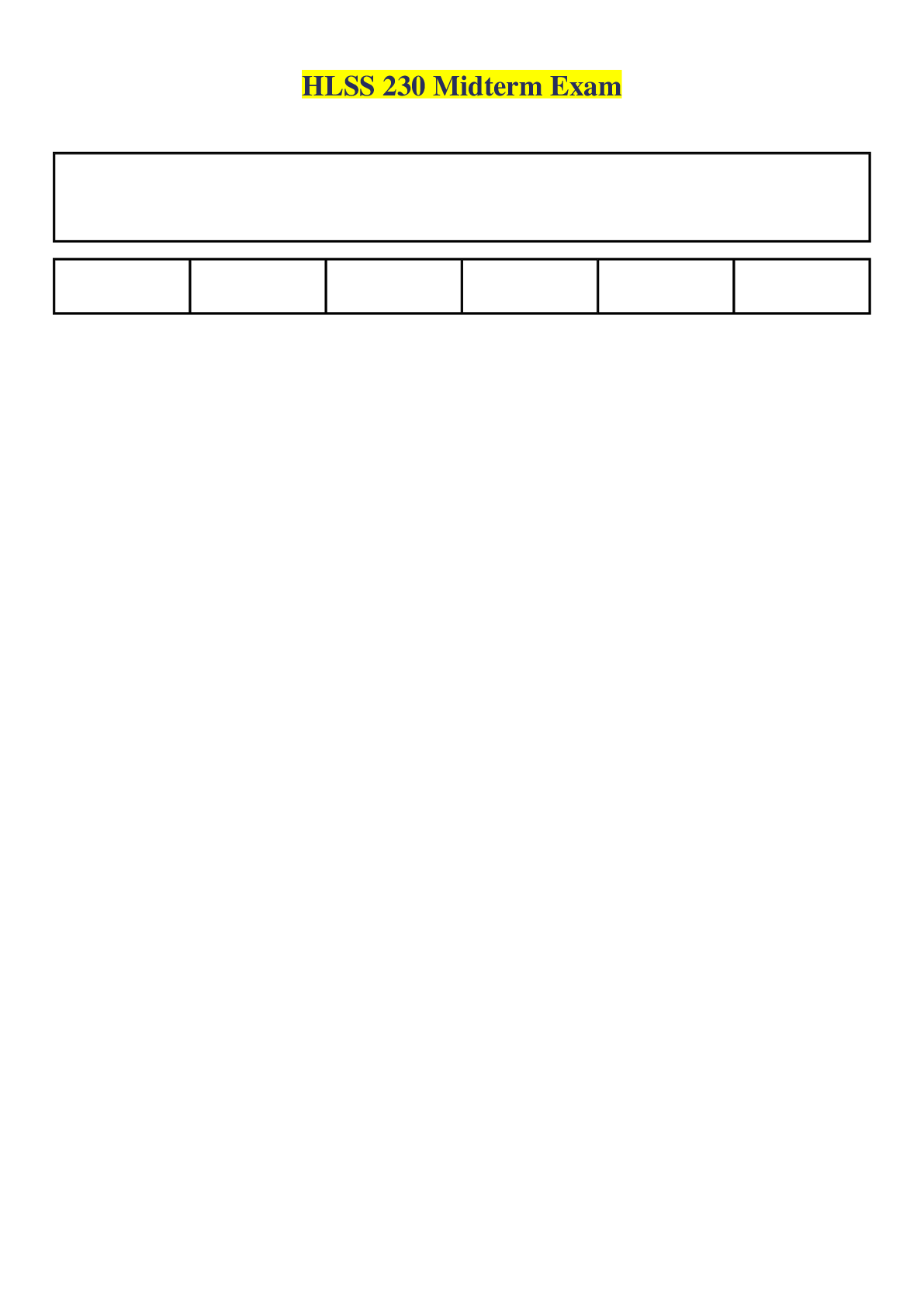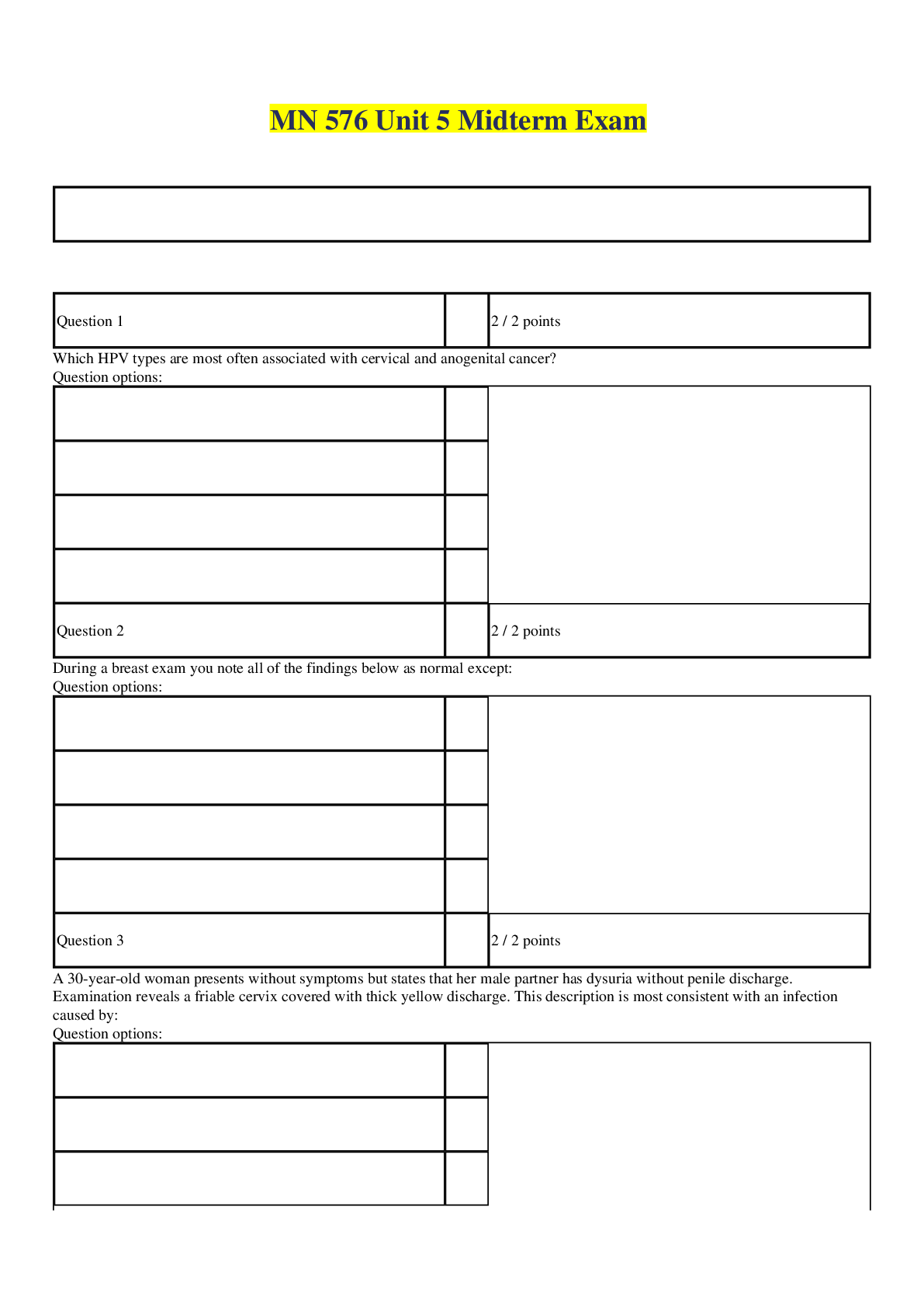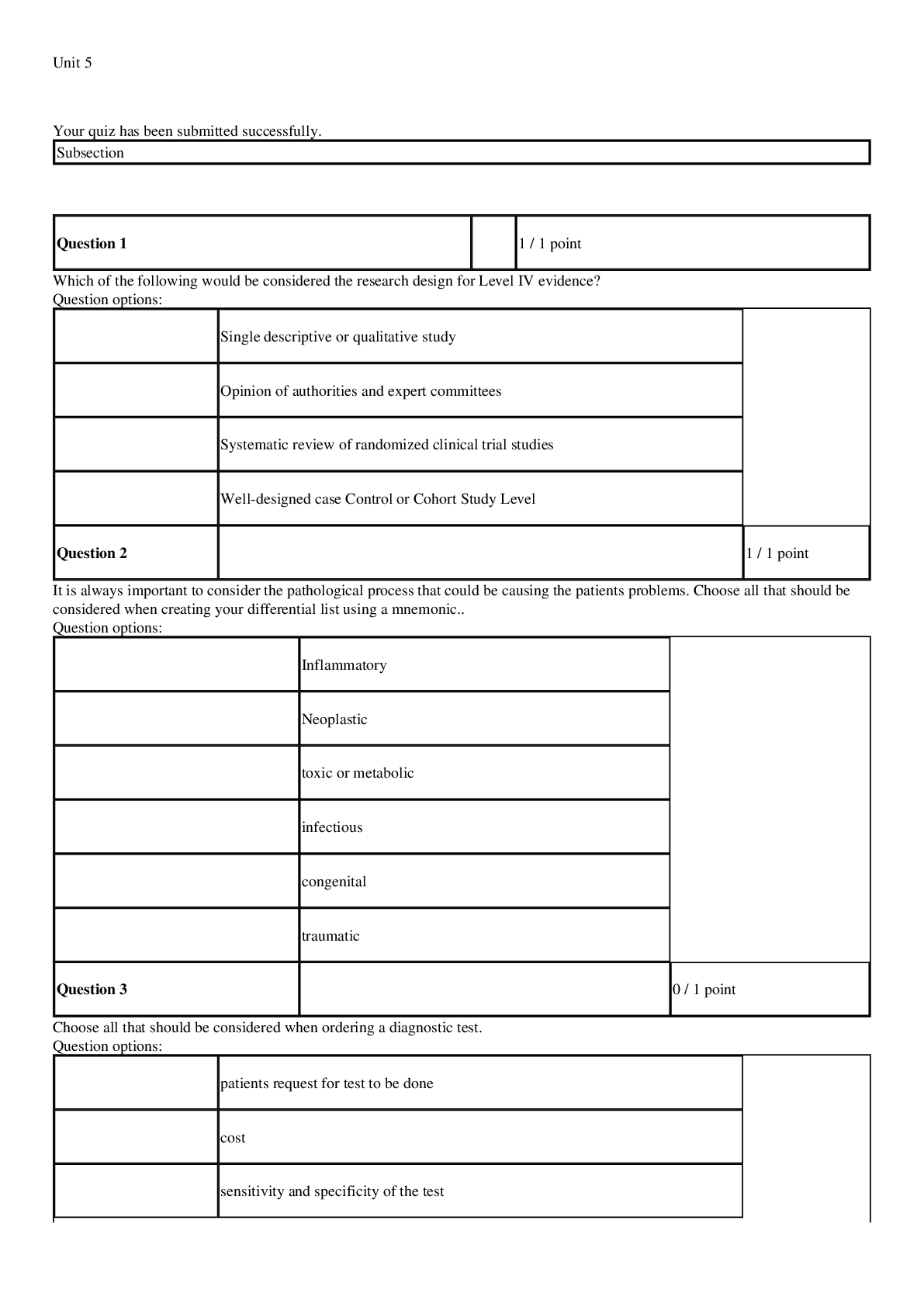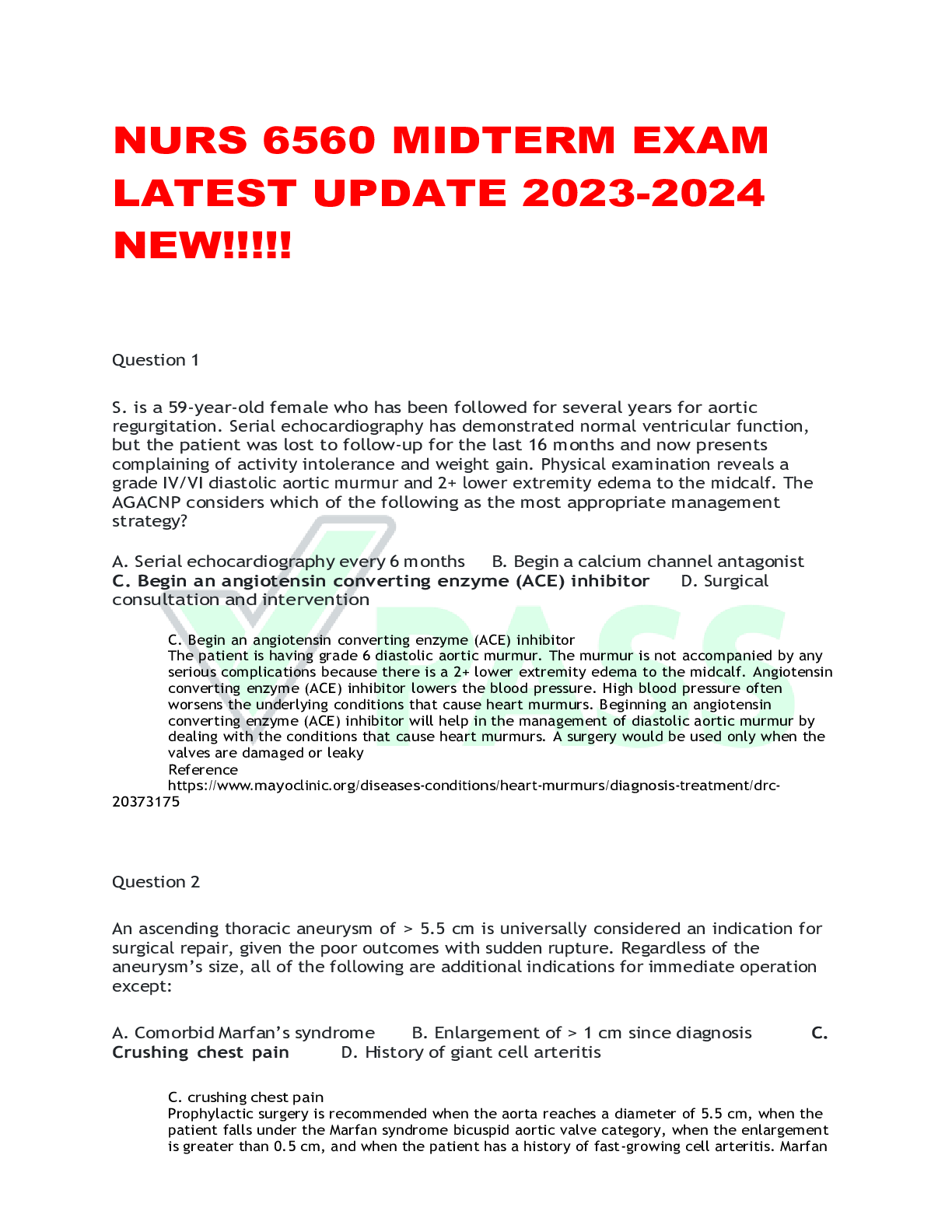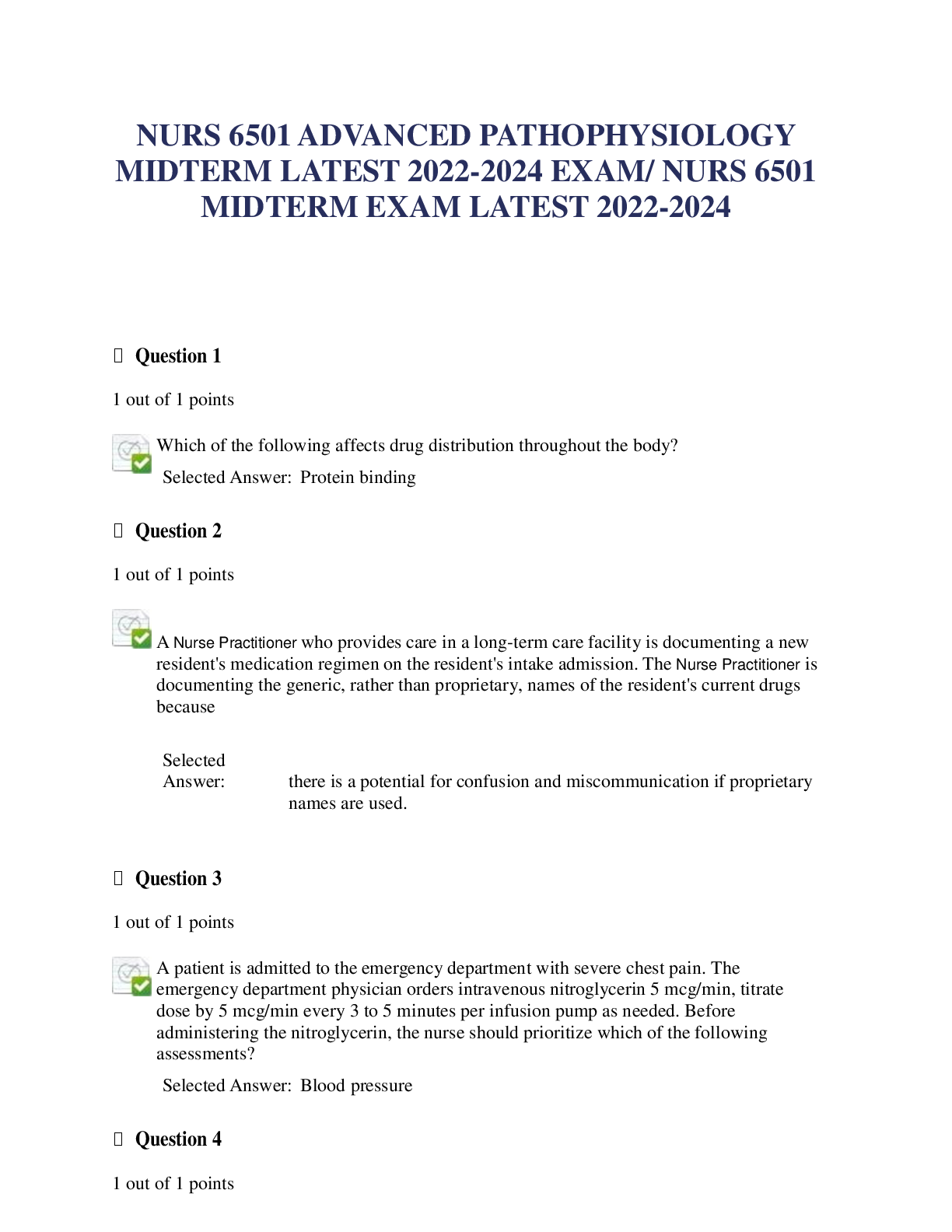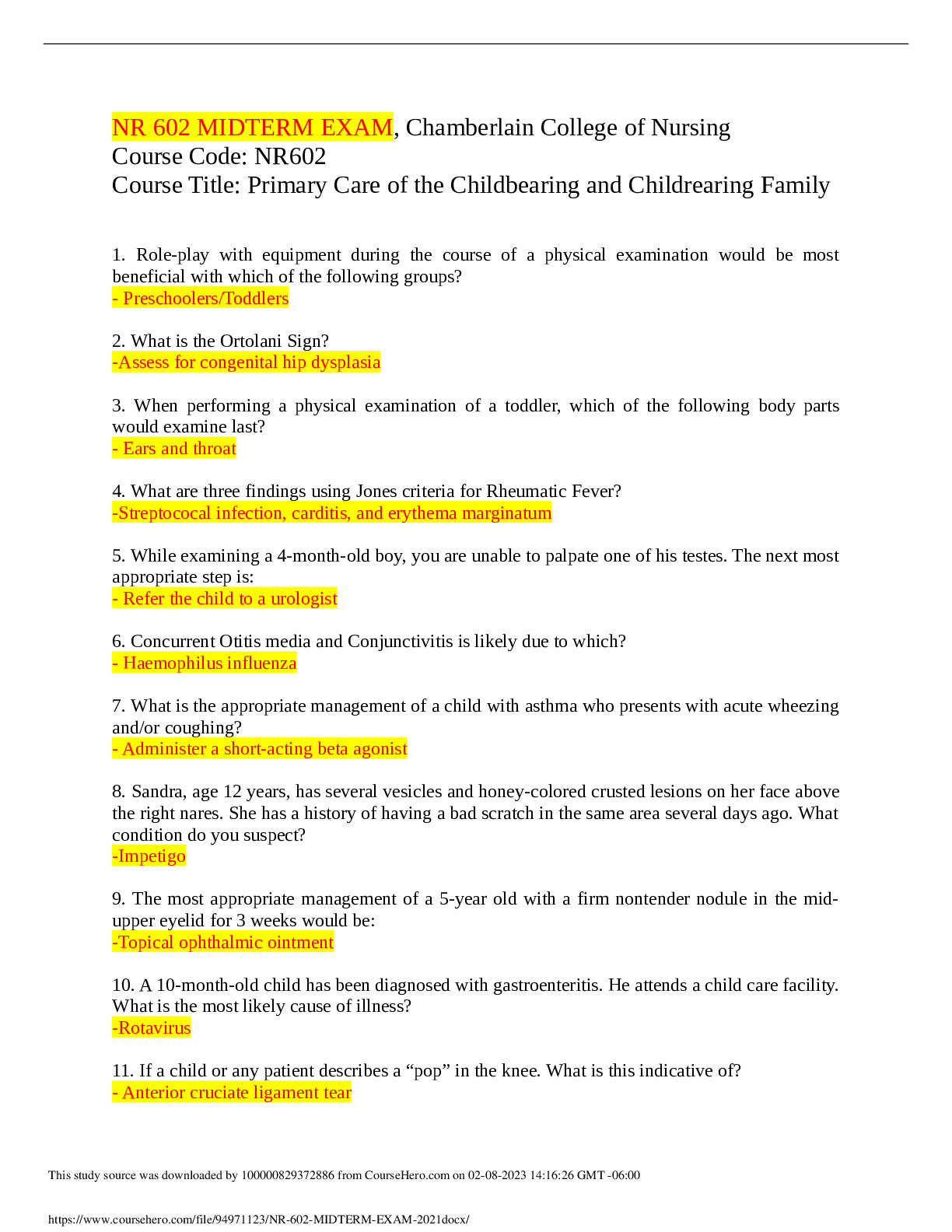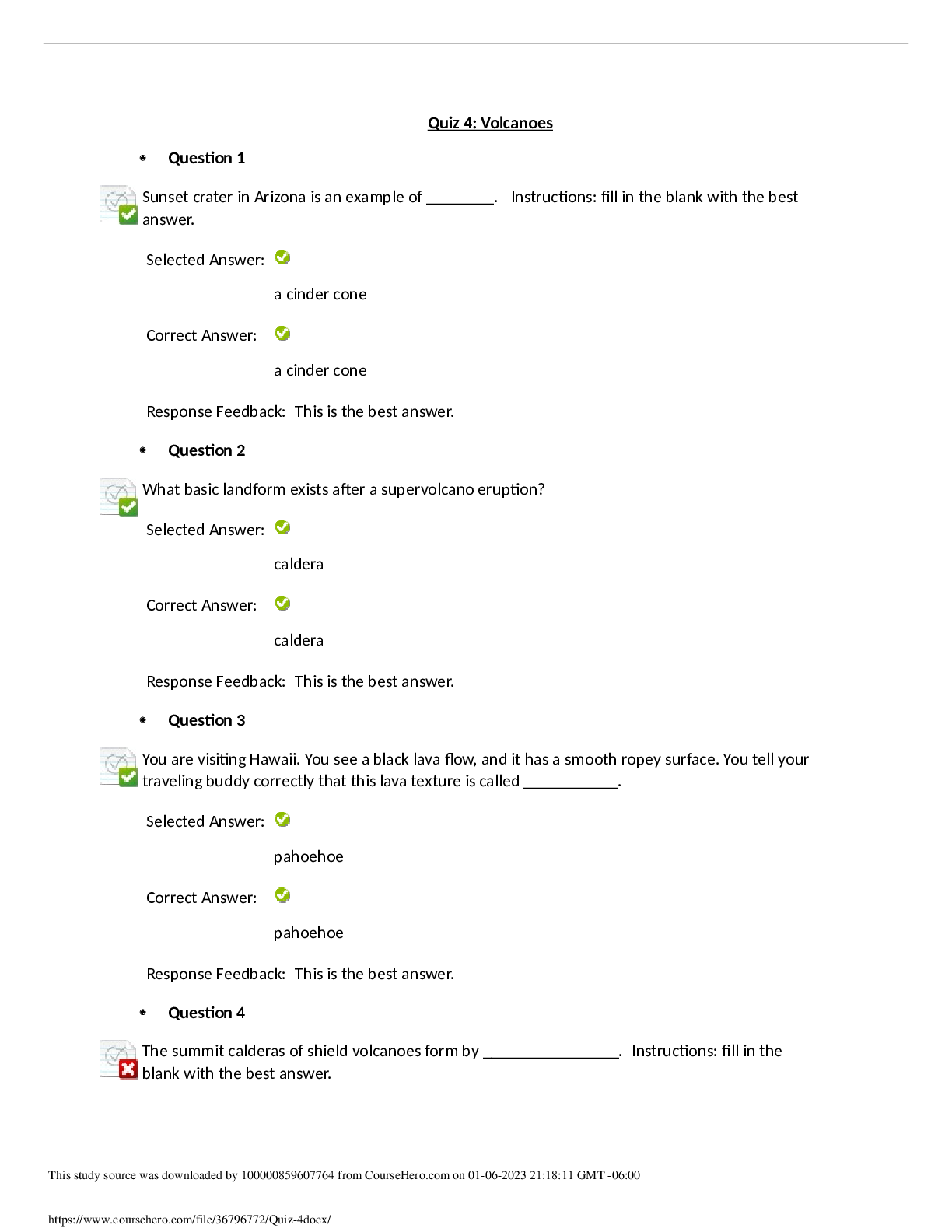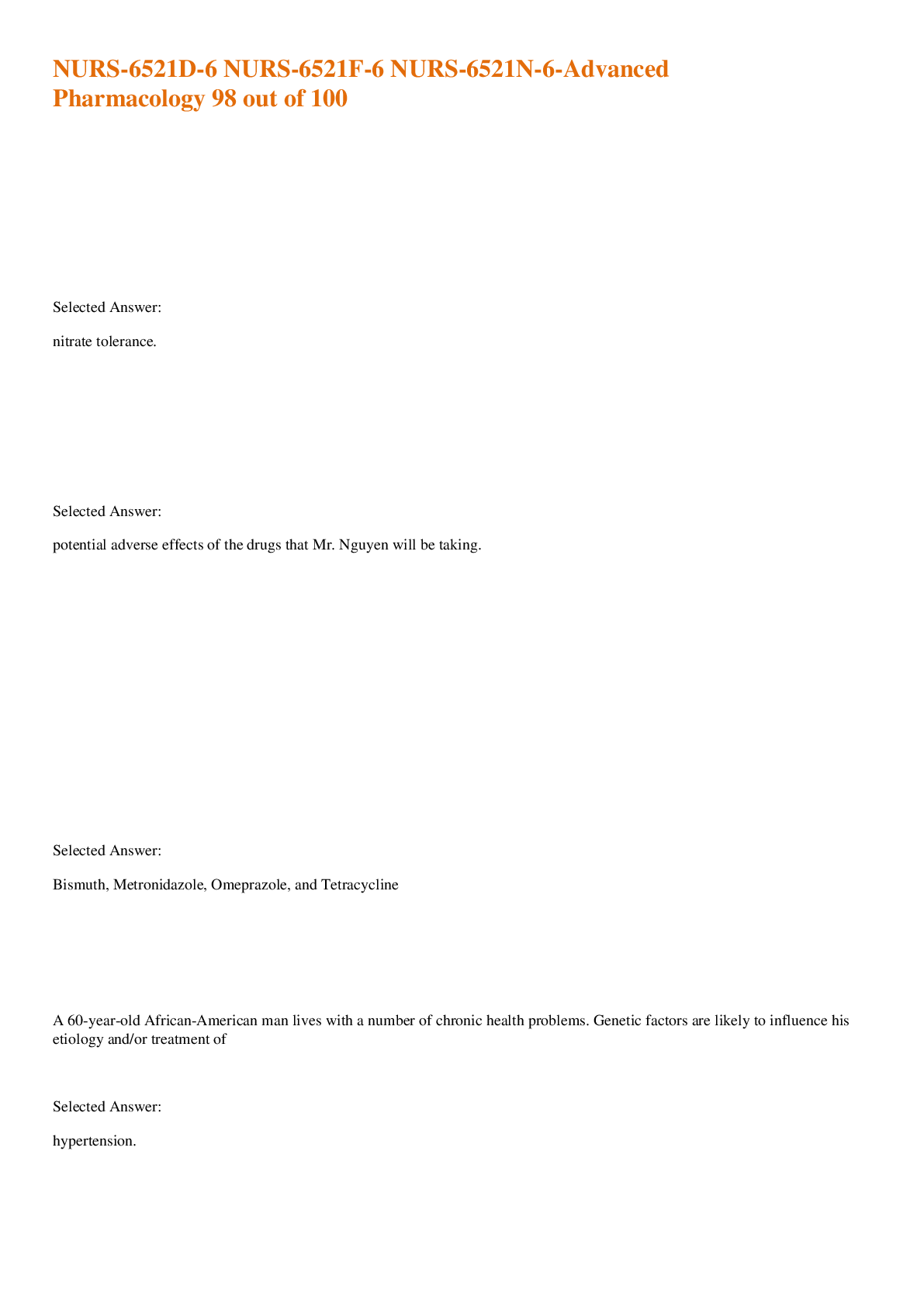*NURSING > EXAM > MN 580 Midterm Exam / MN580 Pediatric Mid Term Exam -Kaplan University (Verified Answers) (All)
MN 580 Midterm Exam / MN580 Pediatric Mid Term Exam -Kaplan University (Verified Answers)
Document Content and Description Below
MN580 FNP II - Primary Care of Children and Adolescents Health Midterm Exam Question 1 2 / 2 points An 18-year-old man presents with periumbilical pain, vomiting, and abdominal cramping over t... he past 48 hours. Physical examination reveals rebound tenderness and laboratory analysis shows the presence of bandemia and a total WBC of 28,000 mm3. To support the diagnosis of acute appendicitis with suspected appendiceal rupture, you consider obtaining the following abdominal imaging study: Question options: 1) Magnetic resonance image (MRI). 2) Computed tomography (CT) scan. 3) Ultrasound. 4) Flat plate. Question 2 2 / 2 points Gina is 2 years old and presents with a 3-day history of fever, crankiness, and congested cough. Her respiratory rate is more than 50% of the upper limits of normal for age. Tubular breath sounds are noted at the right lung base. Skin turgor is normal, and she is wearing a wet diaper. She is alert, resisting the examination as age appropriate, and engages in eye contact. Temperature is 38.3° C (101° F). Gina's diagnostic evaluation should include: Question options: 1) chest x-ray. 2) urine culture and sensitivity measurement. 3) lumbar puncture. 4) sputum culture. Question 3 2 / 2 points Aortic stenosis in a 15-year-old male is most likely: Question options: 1) a sequela of rheumatic fever. 2) a result of a congenital defect. 3) calcific in nature. 4) found with atrial septal defect. Question 4 2 / 2 points Which of the following laboratory tests can identify the causative organism of bronchiolitis? Question options: 1) Nasal washing antigen test. 2) Antibody test via blood sample. 3) Urine culture. 4) A laboratory test is not available. Question 5 2 / 2 points A Still murmur: Question options: 1) is heard in the presence of cardiac pathology. 2) has a humming or vibratory quality. 3) is a reason for denying sports participation clearance. 4) can become louder when the patient is standing. Question 6 2 / 2 points A physiological murmur has which of the following characteristics? Question options: 1) Occurs late in systole. 2) Is noted in a localized area of auscultation. 3) Becomes softer when the patient moves from supine to standing. 4) Frequently obliterates S2. Question 7 2 / 2 points You anticipate that adult car seat belts fit correctly when a child is approximately _____ tall and is____ old. Question options: 1) 51 inches (129.5 cm), 6 to 8 years 2) 53 inches (134.6 cm), 5 to 7 years 3) 57 inches (144.8 cm), 8 to 12 years 4) 59 inches (150 cm), 12 to 14 years Question 8 2 / 2 points Physical examination findings in otitis externa include: Question options: 1) tympanic membrane immobility. 2) increased ear pain with tragus palpation. 3) tympanic membrane erythema. 4) tympanic membrane bullae. Question 9 2 / 2 points In infants, solid foods are best introduced no earlier than: Question options: 1) 1–3 months. 2) 3–5 months. 3) 4–6 months. 4) 6–8 months. Question 10 2 / 2 points When advising a patient about injectable influenza immunization, the nurse practitioner (NP) considers the following about the use of this vaccine: Question options: 1) Its use is not recommended in sickle cell anemia. 2) Its use is limited to children older than 2 years. 3) Its use is limited due to containing live virus. 4) Its use is recommended for virtually all members of the population. Question 11 2 / 2 points A healthy 2-year-old child is able to: Question options: 1) speak in phrases of two or more words. 2) throw a ball at a target. 3) scribble spontaneously. 4) ride a tricycle. Question 12 2 / 2 points The preferred treatment option for a 6-year-old boy with pertussis is: Question options: 1) amoxicillin. 2) ceftriaxone. 3) azithromycin. 4) levofloxacin. Question 13 2 / 2 points At which of the following ages in a young child's life is parental anticipatory guidance about using “time out” as a discipline method most helpful? Question options: 1) 12–18 months. 2) 18–24 months. 3) 24–30 months. 4) 30–36 months. Question 14 2 / 2 points Common causative organisms of acute suppurative conjunctivitis include all of the following except: Question options: 1) staphylococcus aureus. 2) haemophilus influenzae. 3) streptococcus pneumoniae. 4) pseudomonas aeruginosa. Question 15 2 / 2 points At which of the following ages in a young child's life is parental anticipatory guidance about protection from falls most helpful? Question options: 1) Birth. 2) 2 months. 3) 4 months. 4) 6 months. Question 16 2 / 2 points Which of the following statements is true about inactivated poliovirus vaccine (IPV)? Question options: 1) It contains live virus. 2) It is the preferred method of immunization in North America. 3) Two doses should be administered by a child's fourth birthday. 4) After administration of IPV, live poliovirus is usually shed from the stool. Question 17 2 / 2 points Problems after tetanus immunization typically include: Question options: 1) localized reaction at site of injection. 2) myalgia and malaise. 3) low-grade fever. 4) diffuse rash. Question 18 0 / 2 points Which of the following is true about the MMR vaccine? Question options: 1) This vaccine contains live virus. 2) Its use is contraindicated in persons with a history of egg allergy. 3) Revaccination of an immune person is associated with risk of allergic reaction. 4) One dose is recommended for young adults who have not been previously immunized. Question 19 2 / 2 points Treatment of viral conjunctivitis can include: Question options: 1) moxifloxacin ophthalmic drops. 2) polymyxin B ophthalmic drops. 3) oral acyclovir. 4) no antibiotic therapy needed. Question 20 2 / 2 points A healthy 6–7-month-old infant is able to: Question options: 1) roll from back to stomach. 2) confidently feed self a cracker. 3) reach for an object. 4) crawl on abdomen. Question 21 2 / 2 points At which of the following ages in a young child's life is parental anticipatory guidance about temper tantrums most helpful? Question options: 1) 8–10 months. 2) 10–12 months. 3) 12–14 months. 4) 14–16 months. Question 22 2 / 2 points Which of the following findings is most consistent with the diagnosis of acute bacterial rhinosinusitis (ABRS)? Question options: 1) Upper respiratory tract infection symptoms persisting beyond 7 to 10 days. 2) Mild midfacial fullness and tenderness. 3) Preauricular lymphadenopathy. 4) Marked eyelid edema. Question 23 2 / 2 points Which of the following is the most prudent first-line treatment choice for an otherwise well toddler with acute otitis media (AOM) who requires antimicrobial therapy? Question options: 1) Ceftibuten. 2) Amoxicillin. 3) Cefuroxime. 4) Azithromycin. Question 24 2 / 2 points Which of the following is one of the more common sources of hepatitis A infection in the United States? Question options: 1) Receiving blood products. 2) Ingestion of raw shellfish. 3) Drinking municipally sourced tap water drinking water. 4) Exposure to fecally contaminated food. Question 25 2 / 2 points Juice intake is acceptable in children 6 months and older per which of the following recommendations? Select all that apply. Question options: 1) The juice is mixed in small amounts to flavor water. 2) Only 100% juice is used. 3) Juice replaces no more than one serving of milk. 4) The juice is consumed in the morning with breakfast. 5) No more than 6 oz. (177 mL) per day is recommended for children 6 months to 5 years. Question 26 2 / 2 points You are examining an 18-year-old man who is seeking a sports clearance physical examination. You note a mid-systolic murmur that gets louder when he stands. This may represent: Question options: 1) aortic stenosis. 2) hypertrophic cardiomyopathy. 3) a physiologic murmur. 4) a Still's murmur. Question 27 2 / 2 points A healthy infant at age 9–11 months is expected to: Question options: 1) roll from back to stomach. 2) imitate “bye-bye.” 3) play peek-a-boo. 4) hand toy on request. Question 28 2 / 2 points You examine a 10-year-old boy with suspected streptococcal pharyngitis. His mother asks if he can get a “shot of penicillin.” Which of the following statements is/are true regarding the use of intramuscular (IM) penicillin? Select all that apply. Question options: 1) Injectable benzathine PNC G, oral amoxicillin, and cephalexin are each strongly recommended for as treatment of Streptococcus pyogenes (GAS) pharyngitis 2) Injectable benzathine PNC G would be indicated for treatment of GAS if poor adherence to recommended therapy or inability to take full course of oral antibiotics is anticipated. 3) The risk of severe allergic reaction with IM products is similar to that of oral preparations. 4) Injectable penicillin has a superior spectrum of antimicrobial coverage compared with the oral form of the drug. Question 29 2 / 2 points At which of the following ages in an infant's life is parental anticipatory guidance about teething most helpful? Question options: 1) 1–2 months. 2) 2–4 months. 3) 4–6 months. 4) 8–10 months. Question 30 2 / 2 points First-line treatment for uncomplicated hordeolum is: Question options: 1) topical corticosteroid. 2) warm compresses to the affected area. 3) incision and drainage. 4) oral antimicrobial therapy. Question 31 2 / 2 points Which of the following imaging studies potentially exposes the patient being evaluated for abdominal pain to the lowest ionizing radiation burden? Question options: 1) Ultrasound. 2) Barium enema. 3) CT scan. 4) Abdominal flat plate. Question 32 2 / 2 points You are examining an 18-month-old boy who is not speaking any discernible words. Mom tells you he has not said “mama or dada” yet or babbled or smiled responsively. You: Question options: 1) encourage the mother to enroll her son in daycare to increase his socialization. 2) conduct further evaluation of milestone attainment. 3) reassure the parent that delayed speech is common in boys. 4) order audiogram and tympanometry. Question 33 2 / 2 points The gastric parietal cells produce: Question options: 1) hydrochloric acid. 2) a protective mucosal layer. 3) prostaglandins. 4) prokinetic hormones. Question 34 2 / 2 points The most common causative organism of bronchiolitis is: Question options: 1) haemophilus influenzae. 2) parainfluenza virus. 3) respiratory syncytial virus. 4) coxsackievirus. Question 35 2 / 2 points Which of the following would not be found in newborns? Question options: 1) Best vision at a range of 8–12 inches. 2) Presence of red reflex. 3) Light-sensitive eyes. 4) Lack of defensive blink. [Show More]
Last updated: 11 months ago
Preview 1 out of 12 pages
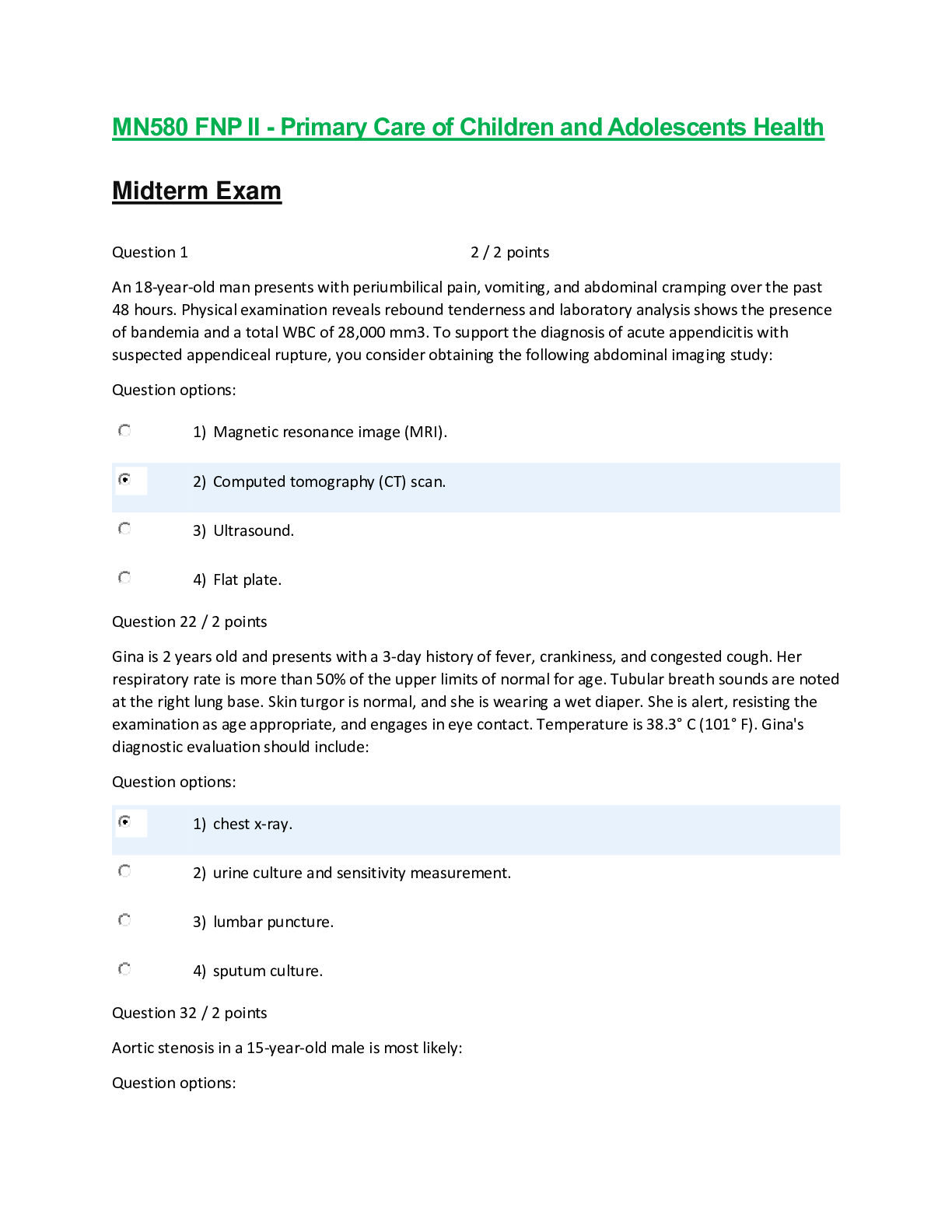
Reviews( 0 )
Document information
Connected school, study & course
About the document
Uploaded On
Dec 03, 2020
Number of pages
12
Written in
Additional information
This document has been written for:
Uploaded
Dec 03, 2020
Downloads
1
Views
79

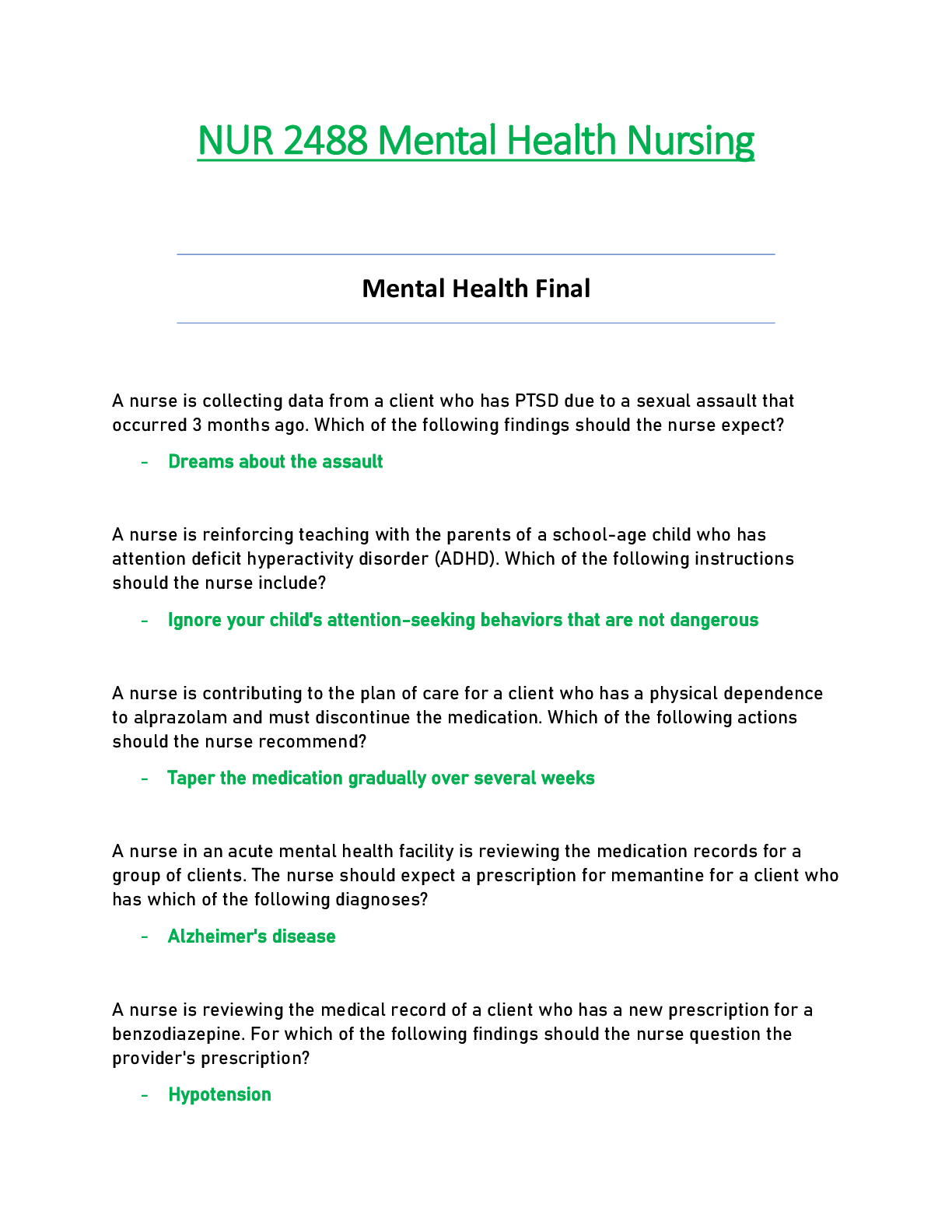
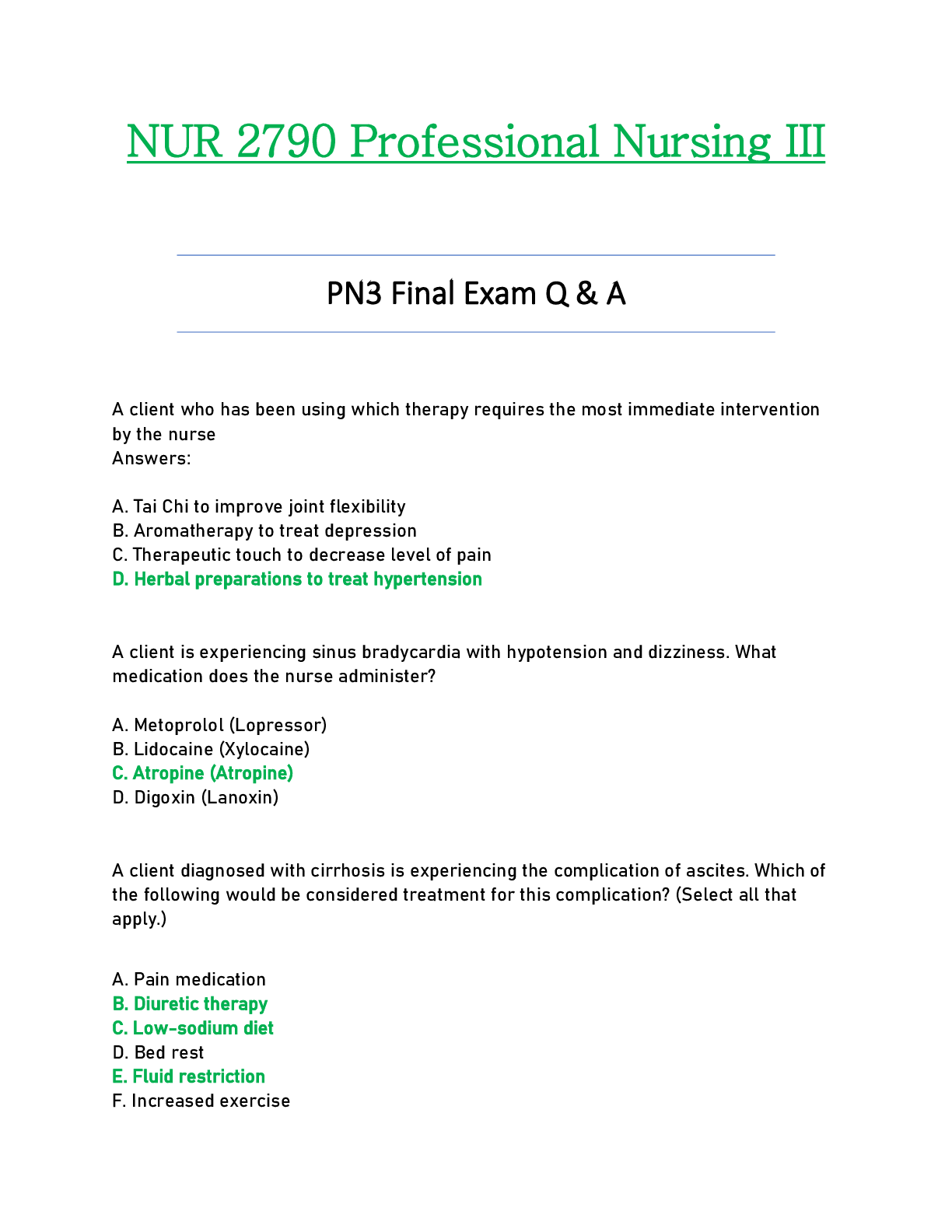
.png)
